PinotFile: 9.29 September 5, 2013
|
Ten Year Vertical of Freeman Akiko’s Cuvée Sonoma Coast Pinot NoirThe history of Freeman Vineyard & Winery had its origins in a happenstance meeting between Ken and Akiko. After college, Ken was a crew member aboard a yacht sailing to the Caribbean, but Hurricane Gloria forced the crew ashore in Larchmont, New York, close to Ken’s hometown. Ken decided to join a party in town thrown by a good friend where he met Akiko. She had only recently arrived from Japan, and as Japanese tradition would dictate, she was dressed formally in a Chanel dress, a striking contrast to the other revelers clothed in jeans and tee shirts. Ken was smitten and after introductory formalities, the two eagerly shared their passion for fine wine, especially Pinot Noir. She had grown up in Japan around wine as her father was a wine enthusiast who often shared special bottles with his family. The date of their meeting, September 28, 1985, is engraved on the keystone at the Freeman winery’s entrance.
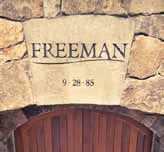 The Freemans launched their winery in 2001 after acquiring a small Russian River Valley winemaking facility and property in Sebastopol on a redwood-covered hillside. Beforehand, they had explored more than 300 vineyards looking to establish an estate program of their own and enlist grower partners. They preferred cool climate wines, and in particular, wines crafted in an eloquent style that were quite approachable upon release, but had enough structure to allow extended development over the long term. The Freemans winemaking goal can be summarized in two words: balance and refinement.
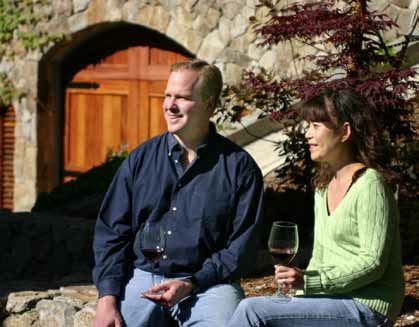 The Freemans enlisted the winemaking expertise of veteran Ed Kurtzman who made the Freeman wines through several initial vintages, working closely with Akiko as a mentor, and eventually becoming a consultant to Akiko as she has gradually assumed the winemaking duties. Ed worked in wine retail and wholesaling before enrolling in the enology program at California State University at Fresno. After graduation, he honed his winemaking skills during stints at Bernardus, Chalone, Fort Ross and Testarossa, before settling in with current winemaking jobs with August West, Roar, Sandler Wine, Mansfield-Dunne, Freeman, and assorted other consulting positions. As one of California’s most accomplished Pinot Noir winemakers, Ed proved to be an invaluable adviser to Akiko and Freeman winery in developing the visionary style of Freeman wines. Akiko is currently aided by assistant winemaker Mitchell Masotti, a graduate of California State University at Fresno. Freeman produces just under 5,000 cases of Pinot Noir, Rosé, and Chardonnay. Grapes are sourced from multiple noted vineyards in the Russian River Valley and Sonoma Coast appellations. The offerings include a Pinot Noir Rosé in some vintages, appellation-designated Pinot Noirs from the Russian River Valley and Sonoma Coast, a vineyard-designated Pinot Noir from Keefer Ranch, a reserve Sonoma Coast bottling known as “Akiko’s Cuvée,” and a Chardonnay labeled “Ryo-Fu,” which means “Cool Breeze” in Japanese. The 7-acre Freeman Estate Vineyard adjacent the winery will produce a vineyard-designated Pinot Noir for the first time from the 2012 vintage. This vineyard is planted to several clones: 115, 667, 777, “828,” Mt. Eden, Swan, Calera and Pommard. Ken and Akiko are very active, hosting tastings at their winery, participating in many Pinot Noir festivals and wine dinners nationwide. They travel extensively and entertain Ken’s banking clients (he is a San Francisco-based investment banker) in their modern home adjacent the winery as well as abroad. Ken was Chairman of the Board of the West Sonoma Coast Vintners this past year and directed the wildly successful West of West Wine Festival held recently in Sebastopol and earlier this year in New York City. Freeman wines are distributed throughout the United States to select retailers and fine restaurants, and several hundred cases are sent to Japan each year. The mailing list is the best way to insure acquisition of the wines. The winery is not open to the public, but tasting can be arranged by appointment (707823-6937). Visit the website at www.freemanwinery.com.
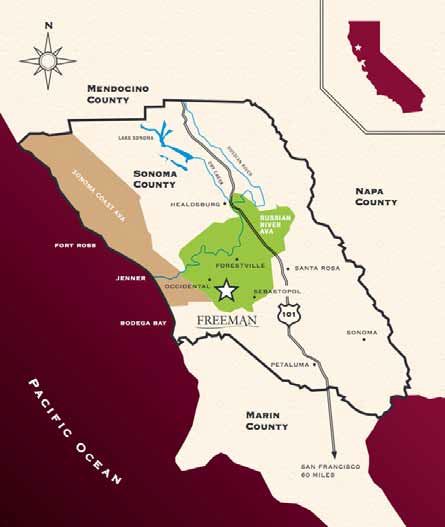 Each year since the inaugural 2002 vintage, the Freemans have released an Akiko’s Cuvée. Winemaker Akiko and consulting winemaker Ed taste each barrel of Pinot Noir from a given vintage in the cellar and choose their favorites. Wines from each person’s favorite barrels are then put together in a blend (or cuvée), and both blends are then tasted blind, so that no one knows who’s barrel selections are in which blend. For ten years in a row, Akiko’s blend has been everyone’s choice. The blend of vineyard sources will vary from year to year. On August 2, I had the distinct pleasure of tasting a ten year vertical of Akiko’s Cuvée Sonoma Coast Pinot Noir at the winery’s cave with Ken, Ed, Akiko and Mitchell. The wines were simply put, impressive. The earlier vintages had aged beautifully and the most recent vintages were very approachable. This last feature is the rub since many wine lovers will not be able to keep their hands off these wines upon release and therefore not experience the nuances that develop over time in the bottle. The style was consistent, yet the wines reflected vintage differences. Each wine displayed an appealing elegance, a moderate and balanced tannic structure, and crisp fruit expression. Finesse was featured over fruit heaviness, especially evident in the more recent vintages. I found that the most striking aromatic vibrancy and purity began to appear with the 2005 vintage wine. My tasting notes follow. When it comes to older Pinot Noir, there is no absolute rating, only a snapshot in time, but the wines were scored to reflect some current judgment. The wines are vinified using a 5-day cold soak, fermentation in open-top bins, punched down by hand one to three times per day, with free run sent directly to barrel and press wine settled and barreled separately.
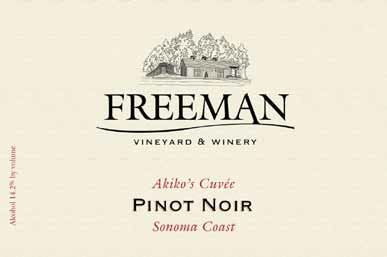
2002 Freeman Akiko’s Cuvée Sonoma Coast Pinot Noir 600 cases. Sourced from Thomas Road and Meredith Estate vineyards. An ideal vintage with a small but fully ripened crop. Aged 15 months in 57% new French oak barrels. · Fresh, moderately dark reddish-purple color in the glass. This wine features dark fruits that are very ripe and an underlying earthiness in the aromas and flavors. Scents of blackberry and black plum lead to fresh flavors of dark berry jam and black cherry with a hint of oak in the background. The tannins are very supple creating a silky texture and the finish has some noticeable length and intensity. Drink or hold shortterm. Score: 90
2003 Freeman Akiko’s Cuvée Sonoma Coast Pinot Noir 140 cases. 86% Meredith Estate, 7% Thomas Road, and 7% Galante. Aged 11 months in 50% new French oak barrels. · Moderately dark reddish-purple color in the glass. Less aromatic than the 2002 vintage, offering shy aromas of dark cherries and berries and spice. Very flavorful, yet light on its feet, featuring discreetly concentrated flavors of blackberries, Bing cherries and black currants. A stylish wine with an earthy bent, fully integrated tannins, and a touch of heat on the fruitdriven finish. Drink or hold short-term. Score: 89
2004 Freeman Akiko’s Cuvée Sonoma Coast Pinot Noir 280 cases. 62% Meredith Estate, 23% Bailey, 8% Thomas Road and 7% Keefer. Aged 11 months in 38% new and 62% 1-year-old French oak barrels. · Moderately dark reddish-purple color in the glass. The wine leads off with earth-kissed aromas of ripe, dark fruits with a hint of spice. Strikingly flavorful on the mid palate with an array of dark red and black stone fruits and berries. Very silky in the mouth with suave fine-grain tannins, bright acidity, and a substantial finish that really hits all the high notes. Drink or hold short-term. Score: 94
2005 Freeman Akiko’s Cuvée Sonoma Coast Pinot Noir 375 cases. 44% Keefer Ranch, 20% O’Connor, 18% Thorn Ridge, and 18% Rayhill. Aged 10 months in 35% new, 41% 1-year-old and 24% 2-year-old French oak barrels. · Dark reddish-purple color in the glass. Very aromatic, offering hi-tone scents of Bing cherries black raspberries, and Asian 5-spice. A bigger, more intensely concentrated wine in this vintage, yet has the backbone to balance the fruit. Delicious layers of deeply colored stone fruits and berries with hints of cola and spice. Finishes with impressive richness. Will easily hold another five years. Score: 93
2006 Freeman Akiko’s Cuvée Sonoma Coast Pinot Noir 505 cases. 30% Rayhill, 25% Thorn Ridge, 15% Guidici, 7% Connell, 5% Sexton, 5% Bailey, 5% Keefer, 5% O’Connor and 3% Meredith Estate (at least one barrel from each of Freeman’s vineyards included). Aged 10 months in 30% new and 79% seasoned French oak barrels. · Moderately dark reddish-purple hue in the glass. Inviting aromas of fresh dark red cherries and berries with hints of briar, forest floor and vanillin. This wine has an appealing savory riff, adding interest to the middleweight core of dark red cherries and raspberries. The oak is complimentary, the tannins are quite modest, and the finish is juicy and refreshing. Drink or hold mid term. Score: 93
2007 Freeman Akiko’s Cuvée Sonoma Coast Pinot Noir 440 cases. 28% Thorn Ridge, 19% Rayhill, 17% Sexton, 15% Morris, 11% Guidici, 4% Horse Ridge, 2% Connell, 2% O’Connor and 2% Keefer. Aged 10 months in 52% new and 48% 1, 2 and 3-year-old French oak barrels. · Moderately dark reddish-purple color in the glass. The nose lacks fruit, offering instead an herbal oak theme. The fruit core, although nicely ripened and featuring dark red and black cherry fruits, is immersed in oak creating a strong dried herb finishing flavor. The texture is smooth and the tannins are well-balanced. Drink. Score: 87
2008 Freeman Akiko’s Cuvée Sonoma Coast Pinot Noir 420 cases. 38% Keefer Ranch, 24% Rayhill, 24% Guidici, 9% Horse Ridge, and 5% Sexton. Aged 11 months in 38% new, 33% 1-year-old, and 29% 2-year-old French oak barrels. · Moderately dark reddish-purple color in the glass. This wine reflects more Green Valley influence from Keefer Ranch. The aromas jump out of the glass with swirling, offering enticing notes of fresh cherries and crushed wild raspberries with a touch of spice. Impressive mid palate presence of an array of dark red fruits that are vivid and juicy. Like chewing on iced cherries. The oak is beautifully integrated, the tannins are well-mannered, the acidity is bright, and the finish is delightful. A lip-smacker. Drink or hold long term. Score: 95
2009 Freeman Akiko’s Cuvée Sonoma Coast Pinot Noir 312 cases. 41% Guidici, 29% Sexton, 12% Rayhill, 6% Thorn Ridge, 6% Bacigalupi, and 6% Spring Hill. Aged 11 months in 41% new, 35% 1-year-old and 24% 2-year-old French oak barrels. · Moderately dark reddish-purple color in the glass. The bright aromas of black cherries, spice and seasoned oak leap from the glass. Racy, discreetly concentrated dark red fruits are complimented by a savory herb and citrus underpinning. This enjoyable wine displays an impressive balance of fruit, acidity and supple tannins and offers an intensely fruited yet refreshing finish. Drink or hold long term. Score: 94
2010 Freeman Akiko’s Cuvée Sonoma Coast Pinot Noir 325 cases. 23% O’Connor, 18% Campbell, 14% Connell, 14% Thorn Ridge, 9% Gunsalus, 9% Rayhill, 5% Sexton, 4% Bacigalupi, and 4% Harmony Lane. Aged 11 months in 27% new, 27% 1-year-old and 46% 2-year-old French oak barrels. · Medium reddish-purple color in the glass. Very lovely aromas of Bing cherry pie filling, baking spices, and a hint of oak. This exceptional wine has it all: a soft, silky texture, vivid cherry and raspberry fruit expression, very suave tannins, uplifting acidity, beautifully married oak, and overall, an appealing delicacy. A thing of beauty. Drink or hold long term. Score: 95
2011 Freeman Akiko’s Cuvée Sonoma Coast Pinot Noir 350 cases. 23% Sexton, 18% Campbell, 18% La Cruz, 11% Rayhill, 6% Thorn Ridge, 6% Jones, 6% Keefer, 6% Harmony Lane, and 6% O’Connor. · Modest reddish-purple color in the glass. Nicely perfumed with aromas of darker fruits with hints of oak spice and rose petals. Dances on the lean side, but still quite flavorful, featuring both red and black berry notes finishing with focus and purpose. Will need more time to integrate the vanilla-infused oak and fully express itself. The characteristic finesse showed by the Akiko’s Cuvée wines is apparent. An impressive effort in this difficult vintage. Drink or hold mid term. Score: 91
2012 Freeman Akiko’s Cuvée Sonoma Coast Pinot Noir Barrel sample. “First fully ripe vintage since 2003,” according to Ed. · Moderate reddish-purple color in the glass. Very fruity nose featuring well-ripened black cherries, black raspberries and plum reduction sauce. Probably the purest fruited nose of all the wines tasted here. The fruit flavors echo the nose, and show impressive richness, maturity and grip on the mid palate. There is plenty of spice to add interest. The finish just sails along. Needs time to fully show what it has but this should turn out to be an extraordinary wine. A Lolita that will easily last 15 years. Score: NR
Weir Vineyard: Getting to Know Winegrower Bill Weir and the Pinot Noirs from His Very Special VineyardThis article is the first in a series of in-depth profiles of distinguished Pinot Noir vineyards in California and Oregon. The vineyards are chosen for their record of producing consistently high quality Pinot Noir over multiple vintages, in some cases by several winemakers. At this time, we lack a classification of vineyards in North America and there is no established nomenclature to signify levels of quality such as found in Burgundy. Bill Weir spent his formative years in Chicago living with his mother after his father died when Bill was very young. His mother moved the family to Mill Valley in Northern California when Bill was 16. After a stint in the marines, he attended junior colleges looking for a career and eventually went to University of California at Berkeley to study architecture and mechanical engineering, both fields that would come in handy in the establishment of his vineyard in years to come. He eventually changed his major to business administration and was encouraged to enter law school. After graduating from Hastings Law School, he successfully practiced law in San Francisco for 40 years. During his years of law practice, Bill made wine in his garage with friends, an activity that led to some marital discord since he had cases of wine scattered all over the house. His wife, Suki, told him, “Your wine is mediocre at best, so stop it.” Bill, who was looking for a long term exit strategy from the practice of law, offered her a compromise. In 1987, he had acquired a 160-acre property in the Yorkville Highlands appellation near Anderson Valley, formerly part of a 5,000-acre sheep ranch. He asked Suki if he could grow grapes there if he agreed to stop making wine. She was receptive, based on two conditions: He had to attend formal viticulture school and he had to look at winegrowing as a business. Beginning in 1989, Bill attended night and weekend classes at Santa Rosa Junior College under the tutelage of Rich Thomas. He also traveled to Burgundy where he sought out advice and insight. In 1991, he had a consultant look at the property and examine the soils. The consultant told him that Syrah, Zinfandel, Pinot Noir and Chardonnay were feasible options. Because of his visit to Burgundy and his personal preference, he decided to plant Pinot Noir. This was a daring decision, since there was no significant precedent for growing Pinot Noir in the Yorkville Highlands.
Yorkville Highlands AVAThe Yorkville Highlands AVA, approved in 1998, is located in the southwestern corner of Mendocino County, between Sonoma County!s Alexander Valley to the South and Mendocino County!s Anderson Valley to the North. The region is 25 miles long, roughly in the shape of rectangle and bisected by Highway 128 which runs the length of the AVA. The region!s terrain is hilly and forested, with elevations ranging from 1,078 to 2,442 feet above sea level. The distinguishing features of the Yorkville Highlands AVA are rocky soils with a high gravel content and the climate, which is cooler than Alexander Valley but warmer than Anderson Valley, and significantly cooler at night than the surrounding areas. Temperatures range from 50º to 77º with an average of 63.5º during the growing season. Total growing degree-days to ripen grapes is 1603.3, making it a Region I in the UCD heat summation classification (source: www.everyvine.com). Of the 44,104 acres, only 0.1% is planted to grapevines. Bordeaux and Rhone varieties make up the vast majority of plantings, and Pinot Noir is usually designated under the tiny “other” category, amounting to only 49 acres compared to the neighboring Anderson Valley!s 1,128 acres (2008 figures from Glenn McGourty). The Yorkville Highlands Growers and Vintners Association, www.yorkvillehighlands.org, lists ten wineries in the appellation. Of these wineries, only Judson Hale Winery grows Pinot Noir. Baldassari is a newer, family owned winery in the AVA producing Pinot Noir. Wattle Creek Winery, located in Cloverdale, also grows and produces Pinot Noir from the Yorkville Highlands. A map of the region follows. Weir Vineyard can be located on this map by following Highway 128 from the AVA!s northernmost border south about 5 miles. Two closely adjacent vineyards in green are noted on the eastern side of Highway 128. These are the two halves of the Weir Vineyard.
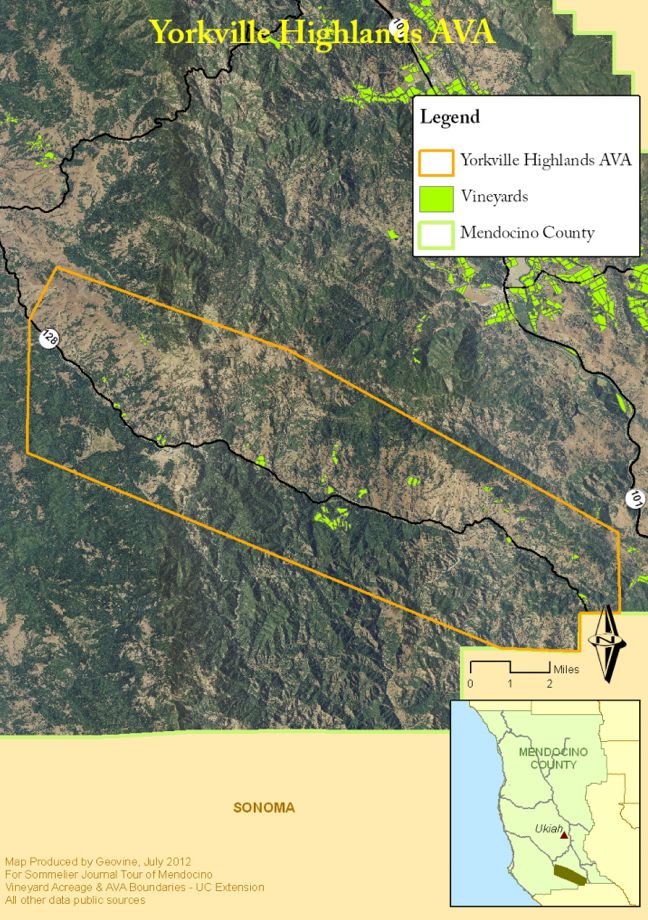 The Weir Vineyard property is located about 7 miles south of Boonville in the Anderson Valley near the headwaters of the Navarro River at 900 to 1000 feet elevation (Anderson Valley in comparison is about 400 feet elevation in Boonville). There is a melange of soils which fall into the Yorkville Series that are mountainous, deep, well drained, and composed of schist, brittle sandstone, and other sedimentary and metamorphic rocks including quartz. Some percentage of loamy clay keeps the soil united. The climate is characterized by dramatic diurnal shifts in temperature of 40º to 50º. Bill considers the diurnal bounce to be the key to the success of his vineyard, since he thinks the nighttime cooling intensifies polyphenol compounds (flavors), preserves acidity, and produces smaller berries during the growing season. (The value of high diurnal temperature variation is a controversial subject among viticulturists). Respected viticulturist Steve Williams was recruited to determine the vineyard!s initial 7.5-acre layout and plant the vineyard. Bill says Steve “gulped” when Bill told him he wanted to plant PInot Noir. In 1990, tree removal began, vines were bench grafted at a nursery in Fresno in 1991, and the vines went in the dirt in June 1992. Wädenswil clone and a rumored DRC selection from Mount Eden were initially planted on 5C rootstock using a VSP trellis system with 8! x 5! spacing. Bill declined to use AXR rootstock because it was not phylloxera resistant. 5C is adaptable to a wide range of soil types, but is not suitable for very dry soils. Bill says the water status of the vines must be carefully monitored, because if the vines become thirsty, they can shut down and not revitalize. Fortunately for Bill, the property has subterranean pockets of water which are sufficient for the 5C rootstock when supplemented by drip irrigation. Bill prefers to limit irrigation, however, believing that pre-veraison water deprivation leads to enhanced grape flavors. Initially, Bill came up to the vineyard on weekends from San Francisco and stayed in a mobile home on the property. He dug a well to supply the vineyard, but within three weeks all of his water was gone. He was forced to pipe in water from a neighboring sheep rancher and the following winter he dug additional wells (he now has five working wells), and established a spring with 10,000 gallon tanks for water storage. His sheep rancher friend, Guido, looked after the property and at one time had 100 head of sheep grazing on Bill's land. The sheep provided a pastoral presence and kept the weeds and grasses down, but when Guido passed away two years ago, Bill let the sheep go. Bill recounts his winegrowing experience, saying, "To grow fine, distinctive Pinot Noir grapes, you need an unending body of knowledge. You need chemistry and biology, even engineering and mechanics as well as the basics of meteorology and just plain farming. The extent of what you don't know limits your results." The initial planting is referred to as the East vineyard ( a 7.5-acre West vineyard was planted later). The south-facing East vineyard is on a hillside and somewhat protected from the wind but cold air rolls down to the bottom area of the vineyard, and Bill found it necessary to protect the vines from frost. In 1995 he installed a large fan, one of the first in the region. The East vineyard is pictured below (the giant fan is visible in the distance).
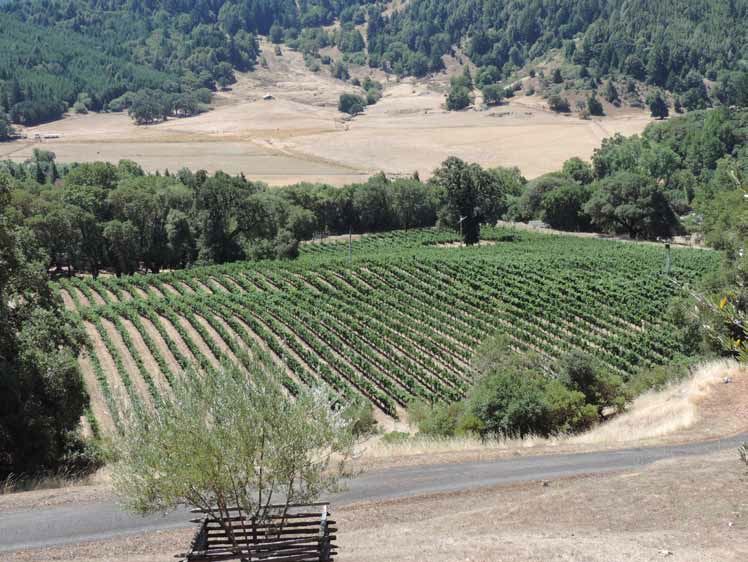 Bill and his family lived in the property!s mobile trailer on the weekends for eight years before his wife and kids put their feet down. They insisted on a shower and inside bathroom, so Bill built a small house in 1997 to maintain family harmony. He has since designed and added a second house, a subterranean wine cellar and a deck for entertaining. The first grapes that were harvested from the East vineyard in 1993 were sent to Gabrielli Winery in Redwood Valley where they were extremely well received. Since the quantity was small, the grapes were mixed with other Pinot Noir grapes. The resulting wine won a Gold Medal at the Mendocino County Fair. The following two vintages, 1994 and 1995 were bottled as a Weir Vineyard-designate by Gabrielli Winery. Now the history gets entwined and highly interesting. In the mid-1990s, Bill had become fond of Williams Selyem Pinot Noir, signed on the mailing list to receive the wines, and made an appointment to see Burt Williams. He took a bottle of 1994 Gabrielli Weir Vineyard Pinot Noir, hoping that Burt might purchase Weir Vineyard grapes. Burt, never one to waste words, tasted the wine and said, “Keep me apprised.” The following year Bill returned with the 1995 Gabrielli Weir Vineyard Pinot Noir and after tasting the wine, Burt said, “Interesting.” Meanwhile, Bill sold some grapes to Keith Rutz at Rutz Winery in the Russian River Valley. Rutz!s winemaker was Dan Moore, also the winemaker at Lynmar at the time. When Moore left, Keith hired Burt!s son, Fred. Fred Williams blended the 1995 vintage at Rutz, made the 1996 vintage and half of the 1997 vintage before departing and starting his own label, Seven Lions. Fred loved the fruit from Weir Vineyard. When Fred left Rutz, Burt came to Bill and said, “OK, I!m ready for your fruit.” A handshake deal was cut at the end of 1997 and the first Williams Selyem Weir Vineyard Pinot Noir debuted in the 1998 vintage. In the spring of 1998, Burt came to Bill and told him the winery was for sale. Bill wanted the grapes to follow Burt, and Burt said he would be consulting for another couple years, but with the sale, a written contract was required. Burt left Williams Selyem after a year, but the grapes have been sourced by Williams Selyem ever since. Bob really beams when he talks about Burt Williams and speaks endlessly about Burt!s achievements. He considers him an icon of California Pinot Noir, setting the gold standard for the varietal in 1983 to 1985. The second 7.5-acre West vineyard was planted in 2000. 50% of the vineyard is the same DRC selection planted in the East vineyard, 25% is Pommard 4, and 25% is a Rochioli Riverblock selection. One small patch of the West vineyard is planted to Nebbiolo. This is Bill!s “pet project” that he planted five years ago and has been struggling with it. He says he is excited about it, and 2013, the fifth leaf, will be a telling year. Photo below shows Bill in the West vineyard.
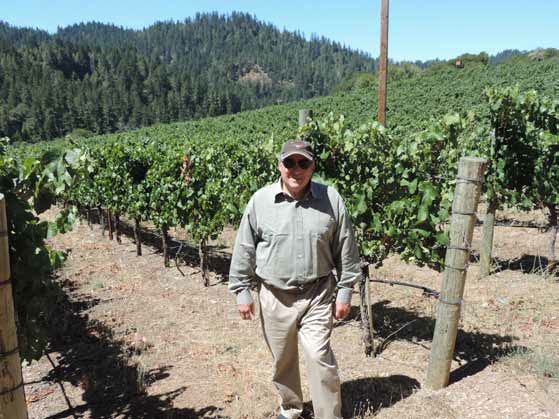 Bill has supplied grapes to a number of noteworthy Pinot Noir producers including Williams Selyem (about 50% of the vineyard!s production), Baxter, Bink Wines, Bluxome Street Winery, Drew Family Cellars, Furthermore, SPELL Wines, Talisman, and Toulouse. He has bottled his own Pinot Noir as well, both as a “Family and Friends” label and as “Lizzy!s Cuvée,” which is donated to raise money to fight cancer (in memory of Bill!s sister-in-law who died from cancer). Bill, himself is a remarkable cancer survivor. In 2006, while being evaluated for kidney stones, he was found to have pancreatic cancer. He was diagnosed with the most aggressive adenocarcinoma type of pancreatic cancer which has a survival rate of less than 5%. Bill was told he had 6 months to live, but was offered a new type of chemotherapy developed by Genentech that required infusions of a drug every two weeks for 48 weeks. He underwent the treatment and despite being in his words, “cooked,” he survived the side effects. He soon felt better, his tumor began to shrink, and within three years had disappeared completely. Bill jokingly remarked, “God must not have been done with him, giving him more time to come up with some great Nebbiolo!” Bill retired in 2007 amid the cancer scare and now spends nearly half his time at Weir Vineyard. When I visited, he was cleaning out dead prey from the vineyard!s owl houses and looking forward to some family members visiting that evening. As we toured the large property and walked the vineyard together, it was clear that Bill was proud of his accomplishments. I felt honored to tell his remarkable story. On his deck overlooking the vineyard, we tasted five Weir Vineyard Pinot Noirs, all of which were special. My tasting notes of these wines follow along with reviews of several more Weir Vineyard Pinot Noirs that I tasted after my visit to Weir Vineyard, some of which Bill kindly supplied. Like so many wine lovers, he relishes the chance to share.
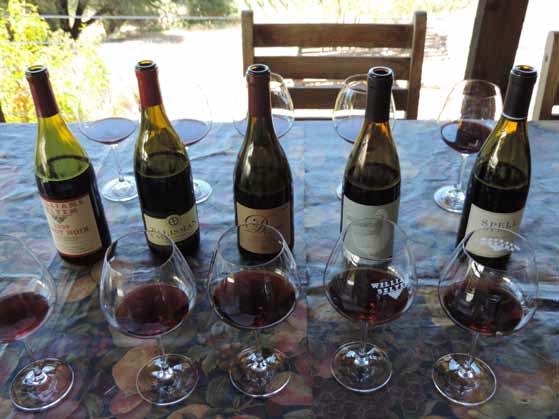 Remington Norman (Grand Cru, 2010) has said, “In addition to its physical and situational components, terroir has a human dimension....Sit over a glass of great Burgundy and discussion rapidly comes around to how far the hand of man, as much as that of plant, site and climate, is reflected in the wine. “Great terroir only represents potential, for man is necessary to bring it to complete fruition.” Weir Vineyard is a perfect example of this. Bill has had considerable influence on his site, soil, and how his vines perform and represents an integral part of the Weir Vineyard terroir Weir Vineyard Pinot Noir displays a number of enticing features including remarkable fruit purity and tension, mid palate richness, bright and mineral-driven acidity, and enough structural bones for age ability. A floral note tends to show up on the nose, and many wines have a savory component. All wines tend to improve over time in the glass with aeration. The most typical and distinguishing feature of every bottle that I have tasted can be summarized by a six-letter word: FINISH. The Weir Vineyard Pinot Noirs offer a finish of heightened intensity and uncommonly generous length which is the hallmark of great wine. It is often said that the feature that most distinguishes a Grand Cru Burgundy is the length of finish. Bill has said, "The deep personal involvement with growing these grapes has tremendously enriched our enjoyment of our lives. We think this will come through in the wine." This is definitely true.
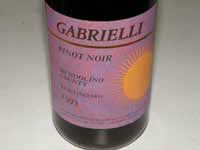 1995 Gabrielli Weir Vineyard Mendocino County Pinot Noir 13.8% alc.. · Dark reddish-purple color with no bricking in the glass. The nose offers some old wine funk along with pleasing notes of black cherry, black olive, worn leather and oak. Still alive on the palate with appealing mid weight flavors of black cherry and blackberry fruit with an earthy, gamey undertone. The tannins are modest, the acidity is uplifting and the finish is strikingly long and crisp. This wine is holding its own after nearly twenty years, and must have been exceptional in its prime. Drink. Score: NR
1999 Williams Selyem Weir Vineyard Yorkville Highlands Pinot Noir 13.7% alc. · Moderately dark reddishpurple color in the glass. The nose is heavily oak-driven but likable, featuring scents of toasty oak, baking spice, vanilla, gingerbread and hazelnut. The black cherry fruit is still holding its own with good richness on the mid palate and finish. An underpinning of earthiness and gaminess adds interest. Silky in the mouth with firm tannins and a good cut of acidity. Drink. Score: 88
2002 Williams Selyem Weir Vineyard Yorkville Highlands Pinot Noir 14.1% alc.. · Moderately dark reddishpurple color in the glass. Very fresh aromas of dark cherries and berries with a hint of cardamom spice. The fruit really sings on the palate and finish, offering vibrant expressions of blackberries, black raspberries, black currants and sassafras. The prodigious fruit is well-balanced by firm tannins and lively acidity. Finishes on a high night with fruit-driven power. Drink. Score: 93
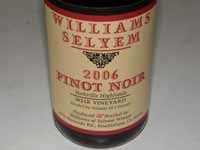 2006 Williams Selyem Weir Vineyard Yorkville Highlands Pinot Noir 14.4% alc., $56. Aged 15 months in 69% new and 31% 1-year-old French oak barrels. · Medium reddish-purple color in the glass. Lovely nose offering dreamy aromas of fresh Bing cherries, rose petals, baking spice including nutmeg and potpourri. Delicious concentrated core of crunchy Bing cherry and black raspberry fruit with a cola accent finishing with a long, long explosion of citrus-infused cherry goodness. Lighter in this vintage, and noticeably crisp with admirable tension and minerality. A seamless wine of impressive sophistication. Drink or hold. Score: 95
2007 Baxter Weir Vineyard Yorkville Highlands Pinot Noir 14.8% alc., 75 cases. · Medium deep red color in the glass. Aromas of red cherries, spice and vanilla. Modest weight flavors of red cherries and berries and pomegranate with a hint of earthiness and baking spice. Bright acidity adds juiciness and the supple tannins add softness. A little alcohol shows up on the finish. Drink or hold. Score: 87
2008 Williams Selyem Weir Vineyard Yorkville Highlands Pinot Noir 14.2% alc., $56. Aged 17 months in 65% new and 35% 1-year-old French oak barrels. · Medium reddish-purple hue in the glass. Aromas of black cherries, spice, earth, dark chocolate and sweet smoke. Middleweight flavors of wild berries and black cherries with a hint of tarry smoke. Balanced tannins with bright supporting acidity and a remarkable long and rich finish. The wine displays subtle signs of smoke taint and reportedly it underwent a filtering procedure in an attempt to remove the smoke taint which was somewhat successful. Drink. Score: 87
2009 Bink Weir Vineyard Yorkville Highlands Pinot Noir 14.2% alc., $38. · Moderately light ruby red color in the glass. Demure aromas of cherries, spice, briar and marzipan. Lighter style, featuring flavors of dark strawberry and cherry with an earthy, cola-driven underpinning. The tannins are fine grain and modest, the acidity is bright and the wine is quite enjoyable although it does not offer the mid palate impact and finish of some other Weir Vineyard wines tasted. Drink or hold. Score: 89
2009 Williams Selyem Weir Vineyard Yorkville Highlands Pinot Noir 13.9% alc., $56. Aged 15 months in 65% new and 35% 1-year-old French oak barrels. · Moderate reddish-purple color in the glass. So aromatic you want to bottle the nose. Scents of dark cherries, spice and loamy earth with a slight savory tone. Very concentrated and flavorful, featuring dark berries, black cherries, cola and spice. Intense, eyebrow-raising, long, long finish. Fabulous. Drink or hold. Score: 97
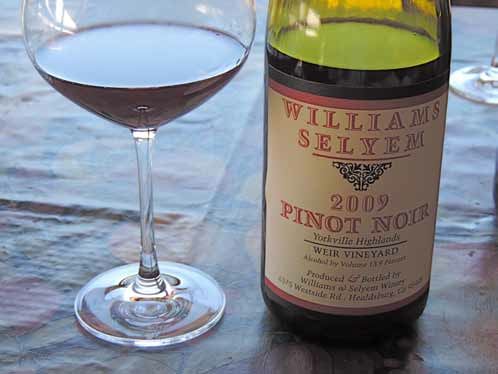
2009 Drew Weir Vineyard Yorkville Highlands Pinot Noir 13.9% alc., 180 cases, $42. Average Brix 24.5º at harvest. Yields 2.3 tons per acre. 15% whole cluster fermentation. Aged in 30% new French oak barrels. Unfined and unfiltered. · Moderately dark reddish-purple color in the glass. Aromas of tea leaf, brandy-infused cherries, rose petals and marzipan. Rich core of deep red cherry and black raspberry fruits with a hint of cassis, spice and nuttiness running through. The tannins are firm, the acidity is bright, and the finish is remarkable intense and lengthy. Hold. Score: 90
2009 Talisman Weir Vineyard Yorkville Highlands Pinot Noir 14.5% alc., 237 cases. One of the last to pick in this vintage. · Moderately dark reddish-purple color in the glass. This is an outstanding wine that offers a more savory take on Weir fruit. The middleweight flavors of darker cherries and berries are appealing, the acidity is uplifting, and the herb-driven finish is delightful. Drink or hold. Score: 92
2010 Bluxome Street Weir Vineyard Yorkville Highlands Pinot Noir 14.3% alc., 250 cases, $45. · Medium reddish-purple hue in the glass. Alluring aromas of black cherry, toasty new oak, brier and tobacco. Delicious essence of black cherry pie glaze that coats the mouth and holds on indefinitely for a peacock finish of uncommon length. Still sporting sinewy tannins that need time to soften and integrate. A big gulp of Pinot. Hold. Score: 91
2010 Drew Weir Vineyard Yorkville Highlands Pinot Noir 14.5% alc., 98 cases, $42. 30% stem inclusion, native fermentation, aged 11 months in 25% new French oak. Unfined and unfiltered. · Moderately dark reddish-purple color in the glass. The shy nose unfolds slowly in the glass, revealing aromas of black cherries, black raspberry, briar and violets. The concentrated core of savory dark red and black fruits fill the mouth, caressed by well-matched tannins, underlain with bright acidity, and finishing with good cherry richness and length. Drink or hold. Score: 89
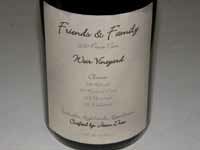 2010 Friends & Family Weir Vineyard Yorkville Highlands Pinot Noir 14.8% alc., 75 cases. Contains all clones from the vineyard: 38% Rochioli, 25% “DRC,” 20% Pommard, and 12% 2A. Winemaker Jason Drew. · Moderate reddishpurple color in the glass. The nose is crazy good with deep, penetrating aromas of wild berries and spice. Soft and smooth on the palate with layered flavors of darker berries and plum sauce with a slight hint of oak in the background. Rich and sappy and definitely on the ripe side, but a delight to drink. Good tension, beautifully crafted, and sporting the signature Weir finish. Lucky family and friends. Drink or hold. Score: 93
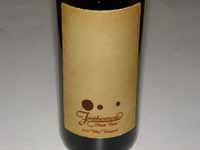 2010 Furthermore Weir Vineyard Yorkville Highlands Pinot Noir 14.4% alc., 76 cases, $50 (375 ml, $25). Average harvest Brix 27.6º. Native fermentation. Aged 12 months in 33% new French oak barrels. · Moderately dark reddishpurple color in the glass. Very nicely appointed wine with lovely aromas of dark red cherries and berries, rose petals and the inside of a woman!s leather glove. Discreetly concentrated core of dark red fruits with a savory, herbal undertone. The oak is well-integrated, the tannins are ripe and balanced, and there is a satisfying kick of acidity on the finish which is of extraordinary length, lasting more than 30 seconds. Drink or hold. Score: 92
2010 Toulouse Weir Vineyard Yorkville Highlands Pinot Noir 14.4% alc.. · Moderately light garnet color in the glass. The leanest interpretation of this vineyard that I have tasted, but a solid wine. Aromas of cherries, violets and spice. Dark red fruit flavors with an earthy, savory bent are featured on the modest palate. Lively and fresh, with some finishing presence. Drink. Score: 87
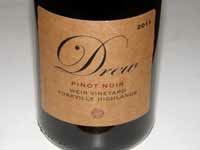 2011 Drew Weir Vineyard Yorkville Highlands Pinot Noir 13.3% alc., 99 cases, $42. Average Brix 23º at harvest. Yields 2.1 tons per acre. 50% whole cluster fermentation. 100% native fermentation. Aged 11 months in 25% new, 25% 1-year-old and 50% 2-year-old French oak barrels. Unfined and unfiltered. · Moderately light reddish-purple color in the glass. Very nicely appointed nose offering scents of cherries, pear and exotic spices. Lighter in this vintage, with an array of layered red fruits that fill the mouth with pleasure. Savory dried herbs and spice add interest. The tannins are well-behaved, the acidity brings focus and brightness to the wine, and the typical Weir finish leaves a lasting impression. This wine is showing definite whole cluster influence now with a slight green tone, and should age extremely well. Drink or hold. Score: 91
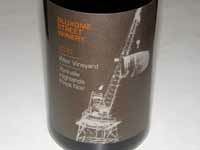 2011 Bluxome Street Weir Vineyard Yorkville Highlands Pinot Noir 14.2% alc., 175 cases, $45. · Medium garnet color in the glass. The nose is really enticing, offering scents of briar, red cherry, and violets, but the flavors are remarkable. Red and black cherries, red plums. brewed tea and spice coat the mouth and finish with a peacock tail of glorious note. The finish lasts at least a minute, returning several times for an encore. In addition, the wine is seductively soft and smooth on the palate with a good cut of underlying mineral-driven acidity. The whole package. Drink or hold. Score: 96
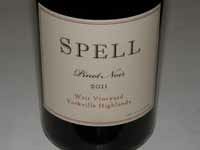 2011 Spell Weir Vineyard Yorkville Highlands Pinot Noir 13.4% alc.., 90 cases, $50. · Moderate reddish-purple color in the glass. Incredibly fragrant, alive with aromas of black cherries, dark berries, dark red rose petals, mocha, and baking spice. Intense, delicious mid palate flavors of cherry pie glaze, black raspberry, purple plum, spice, and dark chocolate with a touch of oak in the background. Plenty of acid-driven vigor and balanced tannins. Soft in the mouth and easy to drink. The finish is outrageously long, juicy and intense. Score: 95
2010 Weir Vineyard Yorkville Highlands Nebbiolo. Vinfied by Ryan McAlister. Unlabeled. Medium reddish-purple color in the glass. Shy aromas of brandy-soaked cherries, briar and rose petals. Tasty array of mid weight red cherry fruit with some Pinot character and a long finish offering cherry skin and dried herb flavors. The fruit is elevated by fresh acidity but is somewhat buried in muscular tannins. Needs a good steak or ossobuco to tame the tannins. NR.
Judson Hale Winery: New Face in the Yorkville HighlandsJudson Hale is a family owned winery sourcing Pinot Noir from the Walsh Vineyard, planted by Dennis and Mary Lou Walsh, with the help of their son, David, and daughter, Lis. Judson Hale grew up in Virginia, and while earning a degree in plant biology at University of Georgia, he developed an interest in wine. This led him to a degree in viticulture and enology from the University of California at Davis and a winemaking program in Dijon, France, where he met his future spouse, Lisa Walsh. Judson and Lisa founded the Judson Hale Winery with other members of the Walsh family with the goal of produce Burgundian style Pinot Noir and Chardonnay. The Walsh Vineyard was planted in 1996 on their 250-acre Yorkville Highlands ranch. The rootstock is 101-14 and the clone is 667. Almost every member of the Walsh and Hale families were involved in the planting and tending of the vineyard. Situated at 1,400 foot elevation, and experiencing drastic diurnal temperature shifts during the summer, natural spring water nourishes the vines during the late summer months. A winery built on the Walsh’s Yorkville Highlands ranch should be open in time for the 2013 harvest.
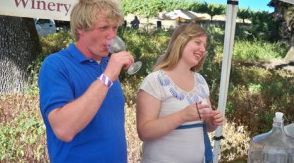 The 2010 Pinot Noir is the first release. Previously, grapes from the Walsh Vineyard were sold to Goldeneye. The wine is available at SIP! Mendocino in Hopland. A 2012 Yorkville Highlands Chardonnay has just been released.
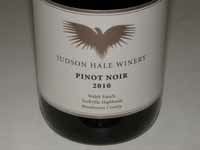 2010 Judson Hale Winery Walsh Ranch Yorkville Highlands Pinot Noir 14.5% alc., $32. · Moderately light reddish-purple color in the glass. Very inviting aromas of spicy cherry, red raspberry and sandalwood, maintaining intensity over time in the glass. Soft in the mouth with a delicious black cherry core and a flattering hint of mocha and savory oak in the background. Nicely balanced with mild tannins, slipping off the back of the palate like a silk sheet. The finish has good richness and persistence. Plenty of Pinot singing in this youthful, inviting wine. Score: 91
On the Pinot Trail at De La Montanya & CuvaisonI was in Sonoma County in early August and visited both De La Montanya Estate Vineyards & Winery in the Russian River Valley and Cuvaison Estate Wines in Napa Carneros. Here is a report on my experience and the wines I tasted.
De La Montanya Estate Vineyards & WineryIt has been a couple of years since I last dropped in to see Dennis De La Montanya, the seventh generation in a long line of farmers, purveyors of wine, and some suspicious endeavors including wine smuggling. Dennis founded De La Montanya Estate Vineyards & Winery in 1995 with the planting of the Home Ranch in the Russian River Valley, and in 2003, the winery and tasting room were opened. Dennis now farms 270 acres of vineyards in Sonoma and Lake counties. The small, but tasteful barn-inspired tasting room and winery is located three miles from Healdsburg just off Westside Road adjacent the estate Home Ranch Vineyard (take Felta Road off Westside Road to Foreman Lane).
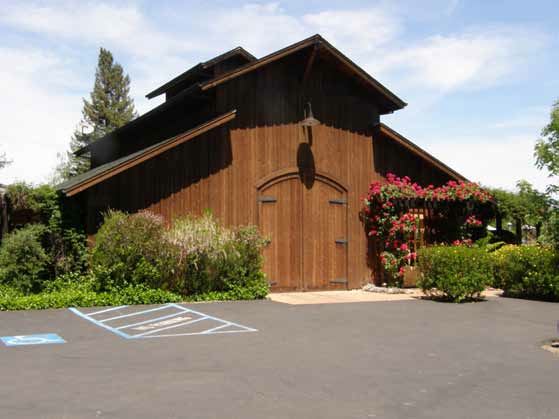 Dennis is a good guy to hang out with. He has a dry wit and an unpretentious way, never taking himself or his wines too seriously, but his wines are produced with the utmost attention. He is unique among Westside Road wineries in that he offers a multitude of varietals (current 18 different wines), both red and white, as well as a number of special bottlings produced in conjunction with rock bands, and various customers who pose for his “Pin-Up” series of wines (these are only sold at the winery since the TTB frowns on the attractive ladies in pinup poses on the labels). Pinot Noir sources include Christine!s Vineyard, Flying Rooster Ranch Vineyard and Willow Vineyard in the Sonoma Coast, and De La Montanya Home Ranch & Tina!s Vineyard, Calandrelli Vineyard and Ridgeway Vineyard all in the Russian River Valley. All Pinot Noirs are 100% de-stemmed and mostly whole berry fermented. Five day cold soak is the norm followed by inoculated fermentation in small open top bins. The wines are pressed and go to barrel just before the wines are completely dry. Total production is about 4,000 cases annually, primarily sold through the tasting room and wine club (members receive a 20% discount). The 2010 vintage wines are nearly sold out. The tasting room is open weekends without appointment and weekdays by appointment. Visit www.dlmwine.com. The winemaker since 2006 has been Tami Collins (Dennis! spouse Tina!s younger sister) who works closely with Dennis who steers the ship. Dennis and Tami are pictured below during my visit.
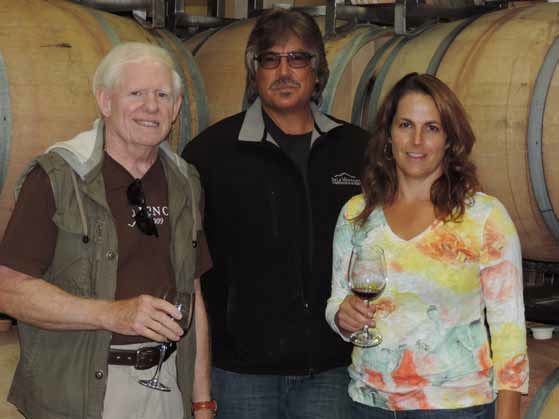
2010 De La Cain Whitesnake Sonoma Coast Pinot Noir 14.5% alc., $30. Produced in conjunction with David Cloverdale of the band Whitesnake. A blend of barrels chosen after the single vineyard barrels are determined. · Fragrant with aromas of strawberries, cherries and spice. Mid weight red fruit flavors with a smoky undertone, backed by modest tannins and finishing with a kiss of cherries. Score: 87
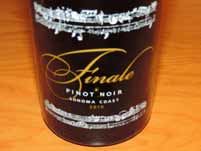 2010 De La Cain Finale Sonoma Coast Pinot Noir 14.2% alc., 53 cases, $60. Produced in conjunction with the band Journey. A “grand reserve” selection of the two best barrels in the cellar. 100% new French oak barrels. · Medium reddish-purple color in the glass. Nicely perfumed with extravagant aromas of red fruits, potpourri and spice. Silky and seductive on the palate, feature a tasty core of red cherry fruit and oak-driven notes of brown spice, dark chocolate and toast. Admirable elegance with supple tannins and bright acidity. Outstanding. Score: 91
2010 De La Montanya Tina's Vineyard Russian River Valley Pinot Noir 14.8% alc., $40. · Moderately light garnet color in the glass. Aromas of Bing cherries and baking spice lead to a focused attack of cherry flavor underpinned with complimentary oak. Light and elegant with suave tannins and good acidity. Score: 87
2010 De La Montanya Flying Rooster Ranch Sonoma Coast Pinot Noir 14.5% alc., $45. From a 60-acre vineyard in the Petaluma Gap. Dijon 115 with a small amount of “828.” · Hi-tone aromatics featuring darker cherries and berries with a subtle note of oak spice. Moderately rich and sappy with very ripe cherry and currant flavors. An enjoyable wine with balanced tannins and a noticeably long finish. Score: 88
2010 De La Montanya Christine's Vineyard Sonoma Coast Pinot Noir 15.5% alc., $45. Late picked at average Brix of 25.5º. · Dark cherries are the theme on the nose and palate. This fruit-driven wine has impressive mid palate richness backed by supple tannins and a good handle of oak. Score: 87
2010 De La Montanya Reserve Sonoma Coast Pinot Noir 15.5% alc., 48 cases, $50 (sold out). Sourced from Christine!s Vineyard and Flying Rooster Ranch. Aged 13 months in 50% new French oak. · Moderate reddish-purple color in the glass. Dark Bing cherries and baking spice are featured on the expressive nose. Full throttle, sappy dark cherry flavor with notes of cola and new oak. Similar to Christine!s Vineyard Pinot Noir. Tasted later in the day from a previously opened and re-corked bottle, the wine leaned more heavily on oak and was a touch hot on the finish. Score: 87
2011 De La Montanya Tina's Vineyard Russian River Valley Pinot Noir 14.9% alc., $40. · Moderately light garnet color in the glass. Bright red cherry and cranberry aromas and flavors carried by lively acidity. A slight green herbal note runs through this relatively lean wine that finishes with a tart, citrus-infused cherry aroma. Just not enough fruit to carry it through. Best if chilled. Score: 85
2011 De La Montanya Flying Rooster Ranch Sonoma Coast Pinot Noir 13.5% alc., $45. · Moderately light reddish-purple color in the glass. More roundness and interest than Tina!s in this vintage. Nicely spiced cherries show up on the nose and palate that has balanced tannins and easy drink ability. A streak of savory herbs runs through. Score: 87
2011 De La Montanya Christine's Vineyard Sonoma Coast Pinot Noir 13.1% alc., $45. · Moderately light reddish-purple hue in the glass. Lighter bodied than the 2010 vintage, but fresher, with more Pinot finesse and charm. Lovely aromas of fresh cherry pie glaze and baking spices. Discreetly concentrated essence of wellspiced cherry and raspberry flavors with suave tannins and admirable balance. Score: 88
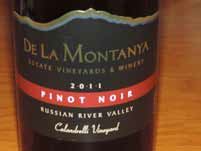 2011 De La Montanya Calandrelli Vineyard Russian River Valley Pinot Noir 14.9% alc., $45. From a vineyard planted in 2006 to “828,” Pommard and 777. Aged 11 months. · Moderately light reddish-purple hue in the glass. Wild raspberries and cherries show up on the fragrant nose that includes hints of cinnamon and nutmeg. Impressive, creamy fullness on the palate featuring an array of dark red and black stone fruits and berries, finishing with generous persistence. Clearly the most outstanding Pinot Noir in the 2011 DLM lineup. Score: 91
Cuvaison Estate WinesCuvaison has a storied history dating to 1969 when two Silicon Valley engineers founded the winery with the establishment of a 27-acre vineyard at the winery!s Calistoga location. The Schmidheiny Family of Switzerland later acquired Cuvaison Estate Wines along with 400 acres of undeveloped land in the Carneros appellation. Eventually vineyards were developed in Carneros and production was moved to a new Carneros winery built specifically for Chardonnay and Pinot Noir in 2004. All Cuvaison wines have been 100% estate since then. Cuvaison celebrated forty years of winemaking in 2009 with the construction of new tasting rooms in Calistoga and Carneros and a new barrel room in Carneros. Cuvaison is pronounced “Koo-veh-ZOHN,” and is a French term for the period when grape juice is kept in contact with the skins during fermentation and maceration. Steve Rogstad joined Cuvaison as the winemaker in 2002 and he has been a regular on the Pinot Noir festival circuit. A graduate of the University of California at Davis, he has had winemaking stints at Saintsbury, Spring Mountain Vineyards, Clos Pegase and Rombauer and worked with custom clients including Viader, Neyers and Dominus. His efforts have led to Cuvaison being named Wine & Spirits 2012 Winery of the Year. The 392-acre Carneros Estate with 250 planted acres receives fog and maritime wind from the nearby San Pablo Bay, creating ideal growing conditions for Pinot Noir and Chardonnay. The shallow clay soils are planted to 57 acres of Pinot Noir, 176 acres of Chardonnay and small amounts of Merlot, Syrah and Sauvignon Blanc (see map of the Carneros Estate Vineyard below). Irrigation is usually needed during the growing season due to the shallow soils and is supplied primarily by reservoirs filled with rain water. Pinot Noir clones are varied and include Dijon 115, 667, 777, “828,” and 459, several heritage selections such as Calera, Swan, Abreu, and Mariafeld.
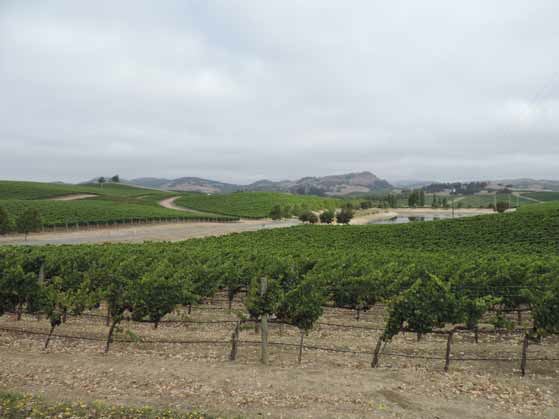
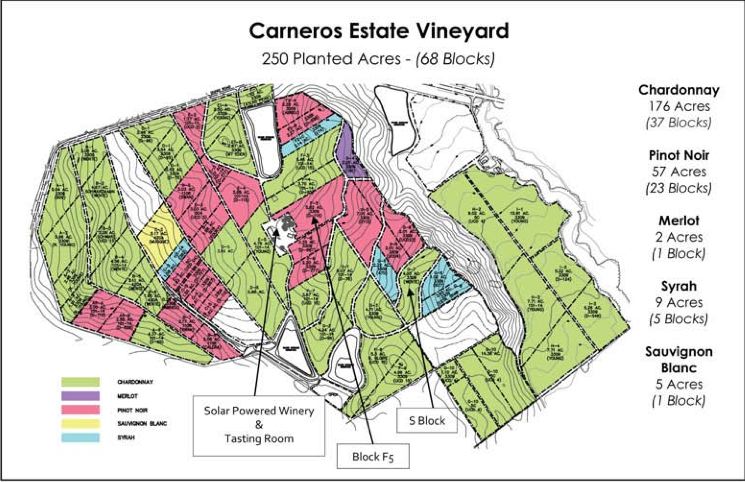 The winery is well-known for Chardonnay and this is its largest production wine by far, but the Pinot Noirs are not to be missed. Current releases include a Vin Gris of Pinot Noir, a 2011 Estate Pinot Noir, and the 2011 Spire Pinot Noir. Spire is a block Pinot Noir produced from a site (Block F5) that is consistently unique each year and always a special wine. After a cold soak, the Pinot Noir is fermented in open top tanks using both native and proprietary yeasts. Whole cluster inclusion is vintage dependent. The Pinot Noir is aged in a modest percentage of new French oak barrels. In 2011, total Pinot Noir production was about 4,500 cases, but the winery can easily manage 6,000 to 7,000 cases in a generous vintage like 2012. Chardonnay is whole cluster pressed, barrel fermented, undergoes partial malolactic fermentation, and is aged in a low percentage of new French oak barrels. Chardonnay production is 30,000 to 40,000 cases.
2012 Cuvaison Carneros Vin Gris of Pinot Noir 14.1% alc., $19. The generous yields of 2012 allowed production of this saignée fermented in a stainless steel tank. · Moderate pink coral color and clear in the glass. Aromas and flavors of fresh strawberries and melon in a crisp, clean and refreshing style of rosé. An ideal aperitif or accompaniment to summer barbecue fare. Score: 87
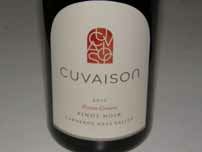 2011 Cuvaison Estate Carneros Pinot Noir 13.5% alc., $38. 100% estate grown blend from twenty distinct blocks in the Cuvaison Estate Vineyard. Average age of vines is 14 years. Each block is vinified separately using open top fermenters, basket pressed and aged 11 months in 33% new French oak barrels. · Medium reddish-purple color in the glass. Aromas of dark red cherries and berries with hints of smoky oak and spice. Very smooth and polished on the palate with an array of flavors including raspberry and plum with accents of anise, grilled mushroom and oak. Bright acidity and a hi-tone finish. Score: 89
2011 Cuvaison Spire Carneros Pinot Noir 14.0% alc., 550 cases, $48. Sourced from a block close to the tasting room planted to clone 115. · Moderate reddish-purple color in the glass. The aromatics offer welcoming scents of black raspberry jam, spice and rose petals. Soft and silky on the palate, with a delicious mélange of wild berry and black cherry flavors with beautifully integrated oak. This wine is clearly special, offering impeccable balance and a finish that really sings. Score: 92
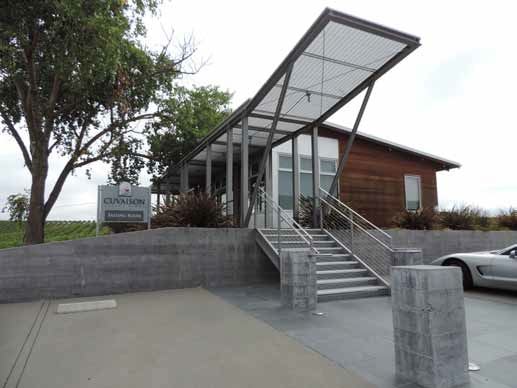 Cuvaison wines are sold on the website and through the two tasting rooms. Significant discounts are offered to wine club members. Both Calistoga (4550 Silverado Trail) and Carneros (1221 Duhig Road) tasting rooms are open daily. Marketing of Cuvaison wines was handled by Terlato for the last fifteen years, but about a year ago, Cuvaison assumed their own direct marketing to reach out to more consumers directly. In addition, the packaging has been updated. The inviting Carneros tasting room is pictured below.
Checking in Down Under
AustraliaDecanter, which is more attuned to Australian wines than the American press is, recently reviewed 81 Pinot Noirs from Victoria, Tasmania and the Yarra Valley (August 2013). The experts lavished praise on the wines. Alessandro Marchesan said, “The Pinots are more complex than those from New Zealand: they come from older vines. Australian Pinot is the best in the New World. We have to help them get out there.” The last comment refers to the fact that very little top notch Australian Pinot Noir is exported to the United States and other countries. Andrew Jefford noted, “2010 is an absolutely jaw dropping, gob smacking vintage. Almost like the Chambolle-Musigny vintage for the Mornington Peninsula.” One wine in particular has garnered rave reviews. The 2010 Eldridge Estate Red Hill Victoria Mornington Peninsula Australia Pinot Noir is from proprietors David and Wendy Lloyd’s 8-acre vineyard planted to some of the oldest (1984) vines in the district. The vineyard is located 90 miles south of Melbourne in one of the coolest subregions in the Mornington Peninsula, and has the a similar climate and latitude and longitude to Burgundy, France. The vines are planted in red clay volcanic loam and are trained to the Scott Henry system of canopy management. The Lloyds have farmed the vineyard since 1995 which is planted primarily to 8 clones of Pinot Noir and 6 clones of Chardonnay. In the 2013 James Halliday Wine Companion, Eldridge Estate was listed as a Five Star Winery. Decanter awarded the 2010 Eldridge Estate Pinot Noir 95+ points. Burgundy importer, Greg Koslosky, called it, “The best Pinot Noir we’ve ever tasted from the Southern Hemisphere.” Unfortunately, only 30 cases were imported to the United States (H. Mercer Imports Inc., Studio City, CA), but you might still snag a bottle. The first three photos below were taken on a trip to Australia a few years ago when I visited Eldridge Estate. I am pleased that the Lloyds are receiving high praise for their wine as they are hard working, dedicated vintners who are also good friends of mine as well as fellow tennis enthusiasts (they just returned from both the French Open and Wimbledon, and spent considerable time in their beloved Burgundy as well).
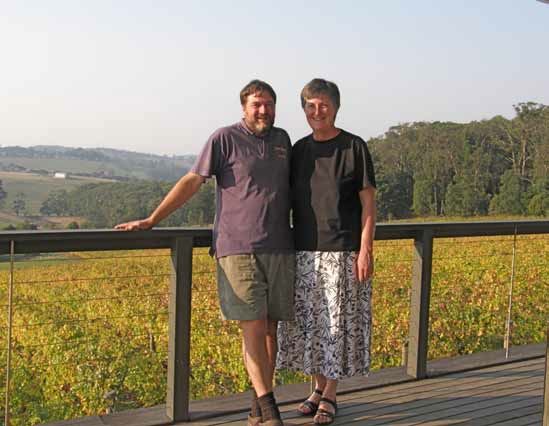 The day I visited, David was ready to harvest Chardonnay so the photos are a collector!s item, showing the Prince of Pinot googling over ripe Chardonnay clusters.
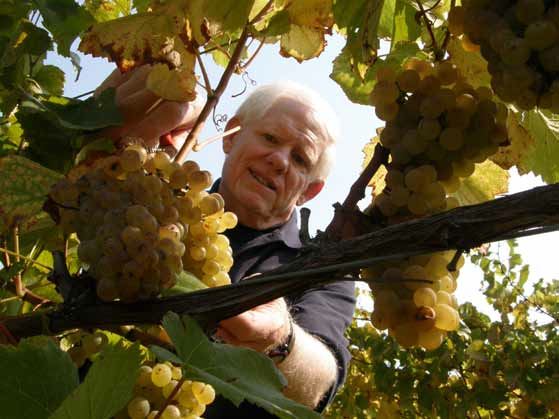
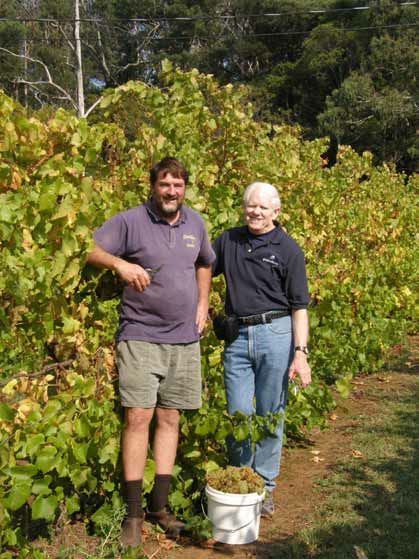 The last photo was taken by David from a helicopter (the ride a present for his 60th birthday) and shows the beautiful Eldridge Estate property
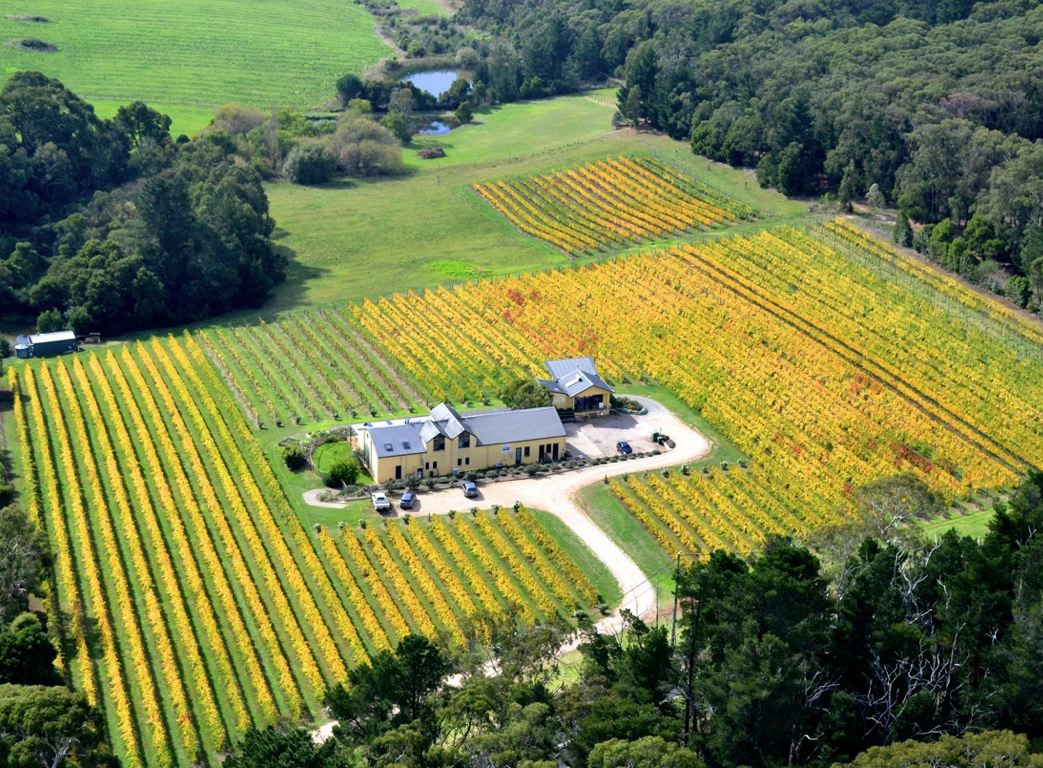 The second Australian Pinot Noir reviewed here is from the same region. Like Eldridge Estate, Mooroodoc Estate is a small, family run winery that has gained a reputation for excellence and is a James Halliday Wine Companion Five Star Winery. The proprietors, Richard and Jill McIntyre, established the Estate in 1981, and farm (either own or manage) four established vineyards planted primarily to Pinot Noir and Chardonnay. The Moorooduc team now includes daughter Kate (MW 2010) and viticulturist Hugh Robinson. The estate is also home to several dogs, two cats, chooks (chickens), ducks and a peacock. Richard McIntyre was an honored guest at the 2013 International Pinot Noir Celebration in McMinnville, Oregon, as the winemaker for 10 Minutes by Tractor. (McIntyre crafts wine for others and his own Mooroodoc Estate).
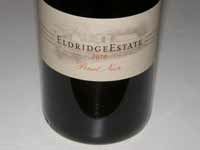 2010 Eldridge Estate Red Hill Victoria Mornington Peninsula Australia Pinot Noir 13.5%, 120 cases, $49.99. Importer H. Mercer Imports, Studio City, CA. Indigenous yeast fermentation, aged in mostly older French oak barrels. · Moderately light reddish-purple color in the glass. Pleasing aromas of red cherries, tea, rose petals and a hint of smoky oak taking on more fruit intensity over time in the glass. Middleweight flavors of red and black cherry backed by well-proportioned dry tannins with nicely integrated oak in the background. Some spice and mineral nuances add interest. Very silky and caressing on the palate with a juicy, bright finish. Score: 91
2010 Moorooduc Estate Victoria Mornington Peninsula Australia Pinot Noir 14.0% alc., 900 cases, $31.99, screwcap. Importer H, Mercer Imports, Studio City, CA. A majority of fruit is from the McIntyre Vineyard. Grapes are de-stemmed and fermented in open top stainless steel vats with a pre- and post-fermentation maceration. Aged in 30% new French oak barrels for 12 to 14 months. · Medium reddish-purple color in the glass. Black cherries and black raspberries are featured on the nose and palate in an intense, concentrated style. A hint of spice and a handle of oak accent the juicy fruit. The tannins are well-behaved, the acidity is balanced, and the wine sails along at the finish with plenty of fruit intensity. Score: 89
New ZealandThere is a much better chance you will find premium New Zealand Pinot Noir in the United States as the small country is exporting well over a million cases of Pinot Noir a year. Unfortunately, much of the exported New Zealand Pinot Noir is very ordinary. Showpiece New Zealand Pinot Noirs are harder to find, but often appear regularly in the stock of stateside fine wine retailers, where the competition from California and Oregon is formidable. Many consumers do not experience enough of a distinct difference to make them preferable to North American Pinot Noir. I try to taste New Zealand Pinot Noir periodically out of curiosity, and over the years have acquired a fondness for the Pinot Noir from Craggy Range and Escarpment from the North Island, and Felton Road, Rippon, Burn Cottage, Pyramid Valley and Dry River from the South Island. Here are a few New Zealand Pinot Noirs I tasted recently.
2010 Rippon Emma’s Block Lake Wanaka Central Otago Pinot Noir 14.0% alc., $75. Imported by Station Imports, Colorado Springs, CO. Sourced from mature vines in a unique parcel within Rippon’s vineyard. The parcel is eastward facing on the lakefront with clay reefs running through schist gravels. The block is named after the great-great-great-grandmother of the current generation of the Mills family who own the winery. Aged 17 months in French oak barrels. Unfined and unfiltered. · Dark reddish-purple color in the glass. Penetrating aromas of deep, dark cherries and black raspberries with hints of peat, loam and oak. Richly endowed core of earthy, dark berry fruits underlain with bright acid tension and a substantial tannic backbone, finishing with uncommon length. More savory and earthy than the Tinker’s Field bottling. Very juicy, with well-managed oak. Softer in the mouth with more appeal the following day from a previously opened and re-corked bottle. Decant if you must drink now, but more bottle aging is preferable. Score: 94
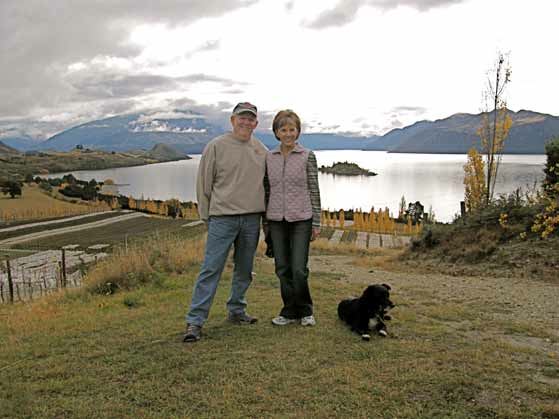
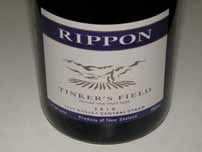 2010 Rippon Tinker’s Field Lake Wanaka Central Otago Pinot Noir 14.0% alc., $90. Imported by Station Imports, Colorado Springs, CO. Sourced from mature vines in a unique parcel within Rippon located on a north facing slope of schist gravels. The oldest vines on the property, the block is named after Rippon’s founder, Rolfe Mills, who was known as “Tink” by his friends. Aged 17 months in French oak barrels. Unfined and unfiltered. · Very dark reddish-purple color in the glass. Slowly emerging aromas of warm dark berries with a loamy, briar and oak presence. Lovely, spicy, tenacious palate featuring an array of dark berries and stone fruits sporting an impressive depth and richness of flavor. Moderate, dry, ripe tannins provide structure for the long haul. Amazingly concentrated, peacock tail finish that sends you looking for superlatives. Decant or age several years in the cellar. Score: 96
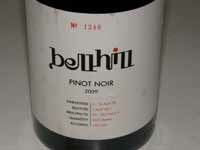 2009 Bell Hill Canterbury Pinot Noir 14.0% alc., 194 cases, $115, screwcap. Imported by Terrell Wines, San Francisco, CA. Established by Marcel Giesen and Sherwyn Veldhuizen in 1997. Situated at a 1920s lime quarry in North Canterbury. 5.6-acre vineyard planted on limestone derived soils on a north facing hillside. 9,090-11,363 vines per hectare. · Moderately dark reddish-purple color in the glass. Aromas of dark red cherries and berries, Asian 5-spice, sandalwood and tobacco-laced oak. Medium bodied core of tasty dark red, oaklaced, cherry and berry fruit lifted by bright acidity, finishing with good richness and a refreshing tang. Mineral-driven acidity is the best feature of this wine. Score: 90
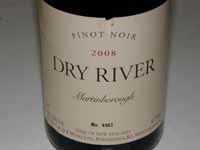 2008 Dry River Martinborough Pinot Noir 12.5% alc., $95. Imported by RO Imports LLC, Napa, CA. · Moderately dark reddish-purple color in the glass. The aromas need time to arrive, eventually showing red berries, spice and vanilla. Delicate in this vintage, with flavors of dark red cherries and berries that are long on the palate. Light on its feet and very supple, the tannins are nicely managed and the wine finishes with some appealing raspberry character. A little better later in the day and much better the next day from a previously opened and recorked bottle. Score: 92
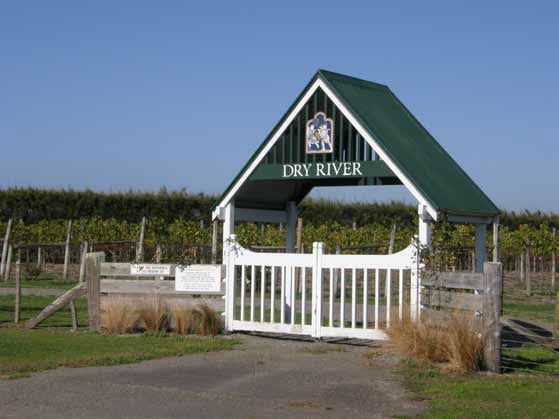
Small Sips of Recently Tasted Pinot Noir and a Few Whites
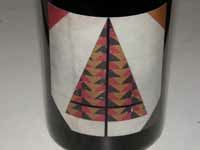 2011 Deux Punx Elk Prairie Vineyard Humboldt County Pinot Noir 12.8% alc., $36. Harvested at 21º Brix. Native fermentation, aged in neutral French oak barrels. · Moderate reddish-purple color in the glass. Very aromatic with bright, clean aromas of fresh red cherries and berries, some rose petal, and a touch of forest floor and bark. Middleweight flavors of black cherries with an interesting, even intriguing, undercurrent of wood plank grilled fruit and veggies. Different, but it works. The wine has impressive length on the finish that sails along. Very smooth in the mouth and beautifully crafted. The tree on the label is appropriate. Still impressive the following day from a previously opened and recorked bottle. Score: 90
 2010 Eric Kent Stiling Vineyard Russian River Valley Pinot Noir 14.6% alc., $48. Cool label by artist Libby Black. · Moderately dark reddish-purple color in the glass. Aromas of very ripe Bing cherries, black grapes and peat moss. Very rich and sappy core of black cherry fruit with riffs of cola and toasted oak in the background. Big, bold and flashy, with a fruit-driven finish that sails along. The tannins are modest and the wine is soft in the mouth. This wine shows a Syrahlike edge to the ripe flavors and has too big a fruit load for my taste, but it is well crafted in its style in a vintage marked by heat spikes. Score: 88
2010 Flying Goat Cellars Rancho Santa Rosa Vineyard Sta. Rita Hills Pinot Noir 14.7% alc., pH 3.65, TA 0.67, 170 cases, $48. Released April 13, 2011. A 225-acre vineyard owned by Foley Family Wines and located on Highway 246 between Buellton and Lompoc. Clone 667. · Dark reddish-purple color in the glass. Highly nuanced nose with aromas of ripe Bing cherry, boysenberry jam, black grape, spice and toasty oak. Full-flavored, featuring dark stone and berry fruit, threatening, but never crossing the over ripe fence. Silky and agile, with balanced tannins and plenty of black cherry and blackberry singing on the finish. Score: 90
2009 Flying Goat Cellars Rio Vista Vineyard Dijon Sta. Rita Hills Pinot Noir 14.5% alc., pH 3.75, TA 0.519, 240 cases, $46. Released April 28, 2012. Clones 115, 667 and 777. Grapes were de-stemmed, inoculated fermentation, hand punch downs, aged 18 months in 35% new French oak barrels. Light filtration followed by additional bottle aging. · Moderately dark reddish-purple color in the glass. The nose is closed for business initially, slowly giving up aromas of black cherry, black raspberry and smoky oak. Extremely pleasurable on the palate due to seamless winemaking and pleasing acid tension. Good depth and richness of dark berry and black plum flavor with a hint of cola, finishing with a slick burst of fruit with noticeable persistence. Even better the following day from a previously opened and re-corked bottle. Score: 91
2010 Flying Goat Cellars Bien Nacido Vineyard Santa Maria Valley Pinot Noir 13.7% alc., pH 3.53, TA 0.59, 148 cases, $50. Released September 29, 2012. Inaugural vintage from this vineyard. Old vines in Block N, Martini clone. · Moderately dark reddish-purple color in the glass. The nose is lacking in fruit, offering aromas of spicy oak and conifer. Mid weight dark red berry fruit has an herbal undertone. Juicy and pleasant with good balance, but not exciting. Just not enough going on in the glass to bring you back. Unchanged the following day from a previously opened and re-corked bottle. Score: 87
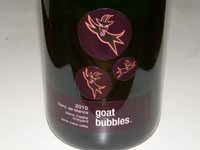 2010 Flying Goat Cellars Sierra Madre Vineyard Santa Maria Valley Goat Bubbles Blanc de Blanc 12.8% alc., 239 cases, pH 3.02, TA 0.82, $38. Released April 28, 2012. Chardonnay clone 15. Whole cluster pressed, cold fermentation, moved to neutral French oak barrels remaining on lees through summer with lees stirring every two weeks to encourage malolactic fermentation. In August, the wine was filtered and decanted into sparkling wine bottles, a tirage of sugar and yeast added and a crown cap applied. Secondary fermentation occurred in bottle. After 9 months of aging, the wine was riddled and then disgorged by hand, a small amount of dosage added, and the wine sealed with the Goat Bubbles signature was cap. · Very cool package and label. Pale golden yellow color with a good bead in the glass. Aromas of lemon and green apple with nutty and yeasty accents. A sublime mix of an array of flavors including lemon, lime, pineapple, vanilla, and almond with a leesey underpinning. Entirely satisfying, with bright, cleansing acidity directing a dry, lemony finish that urges you to take another sip. An extraordinary California sparkling wine at a ridiculously modest price considering the quality and work that goes into producing a wine of this pedigree. Score: 95
2011 Gary Farrell Russian River Valley Selection Russian River Valley Chardonnay 14.1% alc., pH 3.31, TA 0.70, 5,122 cases, $35. A blend from a dozen vineyards. Aged 7 months in 40% new French oak barrels. · Moderate golden yellow color and clear in the glass. Aromas of golden apple, lemon, buttered brioche and toasty oak. A typical Gary Farrell, acid-driven Chardonnay with flavors of apple, lemon and toasted oak with some citrus-driven length on the brisk finish. Score: 87
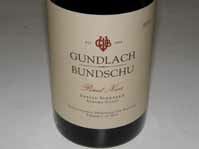 2011 Gundlach Bundschu Estate Vineyard Sonoma Coast Pinot Noir 14.4% alc., pH 3.82, TA 0.58, 2,212 cases, $37. Released August 2013. Eight distinct blocks of Pinot Noir harvested separately from the Estate Vineyard located on the southwestern slopes of the Mayacamas Mountains, 8 miles north of San Pablo Bay. 20% of the blend comes from over 40-year-old heritage selections and 80% is Dijon clones 667 and 777. 100% de-stemmed, 5 to 7-day cold soak, indigenous and RC212 yeast strains. Gentle pump overs avoiding pumping skins and seeds, aged 10 months in 40% new French oak barrels. · Medium reddish-purple color in the glass. Love the nose with its expressive aromas of fresh cherries, strawberries, rose petals and leather glove. Tasty core of red cherry and strawberry fruits with complimentary oak spice in the background. Noticeable mid palate intensity with a rich finish. This is a streamlined wine that is silky soft in the mouth and easy to like. Score: 90
2011 Irony Small Lot Reserve Monterey Pinot Noir 13.5% alc., pH 3.59, $17. From Chris and Jay Indelicato. All wines from the producer are labeled “Small Lot Reserve.” Aged 6 months in American and French oak. · Moderately light reddish-purple color in the glass. The nose offers lively aromas of cherry, strawberry and oak-driven notes of vanilla and espresso which are duplicated in the flavor profile. This wine is relatively simple, the finish is short, and the oak plays too much of a role for my taste, but it is a solid, allpurpose table wine at a very modest price. Widely distributed in the retail marketplace. Score: 87
Note: The J. Wilkes brand was established in 2001 by Jeff Wilkes who I knew well. His wines were always appealing to me. Since his passing, the J. Wilkes brand legacy has continued under the direction of winemaker Vidal Perez, focusing, as Jeff did, on Pinot Noir, Chardonnay and Pinot Blanc. Vidal is a graduate of California State University at Fresno in Viticulture and Enology and is an assistant winemaker at Central Coast Wine Services where Jeff made his wines.
2012 J. Wilkes Santa Maria Valley Pinot Blanc 13.8% alc., 540 cases, $14.99. Stainless steel fermented. · Pale yellow-green color and clear in the glass. Opens with the aroma of freshly sliced green apple but evolves into a grassy-themed nose similar to a Sauvignon Blanc. Delicate flavors of green apple, pear, apricot and citrus with a slight grassy tone. Easy to drink with a slightly creamy mouthfeel. Seems more typical of a Sauvignon Blanc than a Pinot Blanc. Score: 85
2011 J. Wilkes Santa Maria Valley Chardonnay 13.8% alc., 350 cases, $19.99. Fermented and aged in French oak barrels with partial malolactic fermentation. · Moderate golden yellow color and clear in the glass. Aromas of lemon, paraffin, roasted nuts and oak spice. Nondescript on the palate and quite simple, with very delicate flavors of lemon and grapefruit, picking up a little intensity over time in the glass. Smoothly textured with a slight oak imprint. Score: 85
2011 J. Wilkes Santa Maria Valley Pinot Noir 13.7% alc., 550 cases, $26. Fermented with native yeast and barrel aged in French oak for 14 months. · Moderate reddish-purple color in the glass. A smoky, earthy Pinot Noir featuring medium bodied black cherry fruit and hints of anise, tar and oak. Juicy, with mild tannins and an enjoyable finish offering good cherry fruit intensity and refreshing acidity. Score: 87
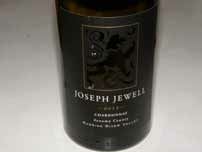 2012 Joseph Jewell Russian River Valley Chardonnay 14.1% alc., pH 3.31, TA 0.71, 626 cases, $22. Clone 4 and 5. Harvest Brix 22.9º-23.4º. Cool fermented in a stainless steel closed top tank (no oak). · Very light yellow golden yellow color and clear in the glass. A highly enjoyable wine offering enticing aromas of baked apple, lemon curd and honey followed on the palate with flavors of apple, lemongrass, honey, and a hint of banana. Admirable restraint and balance, clean and well-defined, with a lively mouth feel, finishing on a high note of refreshing, lemon-driven acidity. Score: 92
2011 Joseph Jewell Russian River Valley Pinot Noir 13.47% alc., pH 3.50, TA 0.61,490 cases, $33. Sourced from Hallberg, Floodgate, Appian Way and Woods Family vineyards. Clones 115, 667, 777 and Pommard 4 and 5. Harvest Brix 23.2º-24.3º. 100% de-stemmed, fermented in stainless steel open top tanks for 7 to 14 days, aged 10 months in 19% new French oak barrels. · Medium reddish-purple color in the glass. A cherry-themed wine with complimentary notes of baking spices and herbal oak. Straightforward, modest in intensity, with lively acidity and gentle tannins. Score: 87
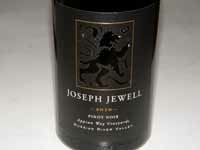 2010 Joseph Jewell Appian Way Vineyards Russian River Valley Pinot Noir 13.7% alc., pH 3.31, TA 0.70, 125 cases, $45. Clones 777, 667 and 115 in Goldridge soil. Harvest Brix 24.4º. 100% de-stemmed. Aged 10 months in 40% new French oak barrels. · Moderately dark reddish-purple color in the glass. Fantastic aromatic presence with electric aromas of dark raspberries, Hoison sauce and exotic spices. The rich core of delicious dark red, spicy berry fruits is elevated by the citrus-driven acid spine. The tannins are well balanced and the finish is generous and focused. Hard to put this one down. Score: 94
2010 Joseph Jewell Floodgate Vineyard Russian River Valley Pinot Noir 13.8% alc., pH 3.51, TA 0.64,150 cases, $42. Clones 777, 667 and 115. Harvest Brix 23.1º-24.8º. 100% de-stemmed.l Aged 10 months in 33% new French oak barrels. · Medium reddish-purple color in the glass. Initially shy, but pleasing aromas of dark red cherries and berries take on more intensity over time in the glass. Mid weight flavors of Bing cherry and dark red berries are complimented by a note of savory herbs and cola. Soft tannins, a silky mouth presence, and respectable finishing length. A charming wine. Score: 90
2010 Joseph Jewell Hallberg Vineyard Russian River Valley Pinot Noir 13.2% alc., 200 cases. · rately dark reddish-purple color in the glass. Deep aromas of black raspberry jam, plum, peat and oak. The flavors duplicate the aromas with a touch of spice and cola. Nicely blended tannins with bright underlying acidity. Seamless and gentle, with a modest tug of oak. A delicate expression of this vineyard in this vintage. Score: 90
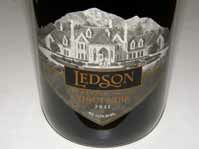 2011 Ledson Anderson Valley Pinot Noir 14.2% alc., pH 3.85, TA 0.50, 386 cases, $60. Brix at harvest 25º. Aged 12 months in French oak barrels. · Moderately light reddish-purple color in the glass. This wine is a real crowd pleaser with its bright aromas of cherries, strawberries, baking spices and mocha. Very tasty and easy to drink with flavors that echo the nose. Velvety in texture with supple tannins and admirable drink ability, finishing with a memorable spicy cherry encore. Score: 91
2011 Ledson Russian River Valley Pinot Noir 13.8% alc., pH 3.95, TA 0.55, 219 cases, $60. Brix at harvest 24.9º. Aged 10 months in 55% new French oak barrels. · Medium reddish-purple color in the glass. Shy aromas of Bing cherries, cranberries, strawberries and cola. Modest dark cherry flavor with an herbal thread running through. On the delicate side for a Russian River Valley Pinot Noir. Soft in the mouth and very approachable, but not enough fruit interest to impress. Score: 87
2011 McNeil & Sons Chileno Valley Vineyard Marin County Pinot Noir 13.5% alc., about 75 cases, $60. Clones 667, 777 and Pommard. Yields 1.25 tons per acre. Native fermentation, 50% whole cluster. Winemaker is Jon Grant (Couloir). · Moderately light reddish-purple color in the glass. Aromas of warm cherry cobbler, green tea leaf, toast and subtle stem. Nicely flavored with juicy, mid weight dark cherry and raspberry fruits with a hint of cardamom spice and oak in the background. Welcoming finesse with balanced tannins and appealing tension. Score: 90
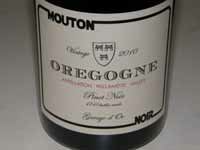 2010 Mouton Noir Oregogne Garage d’Or Willamette Valley Pinot Noir 13.4% alc., 396 cases, $44. Love the play on words and the label which reminds of that famous domaine in Burgundy. · Medium reddish-purple color in the glass. Nicely perfumed with aromas of red cherries, sandalwood and baking spices. Tasty core of dark red cherry and dark strawberry fruits with an underlying streak of tarry oak. Soft, silky, and easy to drink, with some fine-grain tannins and a fruit-filled finish. Score: 88
2012 Ousterhout Dellinger Vineyard Russian River Valley Pinot Noir Rosé 14.1% alc., 70 cases, $NA. From a 1+ acre vineyard in Green Valley of the Russian River Valley. · Moderate pink-orange color and clear in the glass. Aromas of mandarin orange, strawberry and watermelon lead to similar flavors with a hint of tuttifrutti, baked pear, orange zest and vanillin. Nicely composed with appealing delicacy, finishing with some intensity and uplifting acidity. Score: 89
2012 Ousterhout Wood’s Vineyard Russian River Valley Pinot Noir Rosé 14.0% alc., 235 cases, $NA. · Moderate pink-orange color and clear in the glass. The aromas of raspberry and peach take on more vibrancy over time in the glass. Similar in flavor profile to the Dellinger Vineyard bottling with delicate notes of orangeflavored cranberry, strawberry, raspberry, orange zest and herbs. Slightly creamy with a good zip of acidity on the finish. Needs some foreplay to bring out its best. Score: 88
2011 Paul Hobbs Ulises Valdez Vineyard Russian River Valley Chardonnay 14.3% alc., $72. Harvest Brix 24.2º. Barrel fermented with indigenous yeasts, aged 15 months in 67% new French oak barrels, aged sur lies with biweekly batonnage. Unfined and unfiltered. · Moderate golden yellow color and clear in the glass. Opens nicely in the glass to reveal a perfume of buttery brioche, apple and lemon blossom. Well-crafted with inviting flavors of fresh apple, pear, lemongrass and honey, with just the right handle of nutty oak. Creamy on the palate with some finishing presence. Score: 90
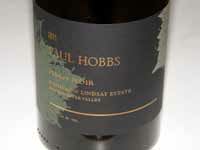 2011 Paul Hobbs Katherine Lindsay Estate Vineyard Russian River Valley Pinot Noir 14.2% alc., $80. Goldridge sandy clay loam. Harvest Brix 25.2º. Indigenous fermentation in stainless steel open-top fermenters. 5% whole cluster. Aged 15 months in 63% French oak barrels. Unfined and unfiltered. · Dark reddish-purple color in the glass. Lovely aromas of Bing cherries, dark berries and dark chocolate. Soft and smooth as a baby’s bottom, with good depth and richness of dark berry, cola and clove flavors, and finishing goodness. A ripe, juicy, and generous wine with modest tannins and a good tug of oak on the finish. Score: 92
2010 Rhys San Mateo County Pinot Noir 13.3% alc., $NA. · Medium reddish-purple color in the glass. Very aromatic with expressive aromas of black cherry and exotic spices with a hint of toasty oak. Tasty mid weight flavors of black cherry and black raspberry with a savory riff of tar, stem and tobacco. Juicy, with suave tannins, this forward drinking wine is solid but not exceptional. Score: 87
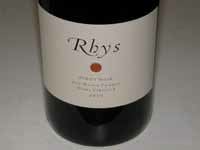 2010 Rhys Home Vineyard San Mateo County Pinot Noir 12.5% alc., $79. A field blend grown in decomposed sandstone. First vintage that includes new and old sections. · Medium reddish-purple color in the glass. Reserved, but pleasing aromas of darker red and black stone fruits and berries with hints of forest floor, Asian 5-spice, mushroom, cut flowers and toasted oak. Soft in the mouth with reserved tannins and a good cut of acidity. Lighter in this vintage, and approachable now, but is a little brooding and should benefit from more time in bottle. Score: 90
2010 Rhys Bearwallow Vineyard Anderson Valley Pinot Noir 13.4% alc., $59. · Medium reddish-purple color in the glass. Delicate aromas of cherry, spiced red plum and rose petals. Lighter in weight with redder fruits than the 2009 vintage, but offering fresher and juicier strawberry and cherry flavors. Mild, soft tannins and good vibrancy, this wine has more tension and appeal than the previous vintage. Score: 89
2009 Rhys Bearwallow Vineyard Anderson Valley Pinot Noir 13.9% alc., $59. 6.56 acres planted to 115, 777 and Pommard clones. Walfey-Bearwallow series soils consisting of 6 to 24 inches of topsoil over deep fractured shale. · Moderately dark reddish-purple color in the glass. Satisfying fruity aromas including an array of dark berries and plum with a hint of vanilla. The core of dark berries and black plum flavors are saturating and bring the mid palate to attention. Creamy soft in the mouth with a generous fruit-driven finish. Riper fruit than in 2010. Score: 88
2011 Seven of Hearts Special Reserve Willamette Valley Pinot Noir 12.5% alc., 133 cases, $42. Clones 114, 115, 777, Pommard, Wädenswil and Mariafeld from four sub-appellations including both volcanic and sedimentary soils. Aged in 27% new French oak barrels. · Moderately light reddish-purple color in the glass. Aromas of cherries and berries, mushrooms, exotic woods and espresso. Tasty core of red cherries, cranberries and strawberries with engaging acidity. Light on its feet and modest in concentration, but flavorful. Much more intensity the following day from a previously opened and re-corked bottle. Score: 89
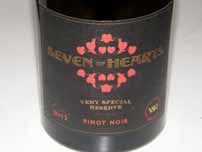 2011 Seven of Hearts Very Special Reserve Willamette Valley Pinot Noir 12.5% alc., 98 cases, $75. Clones 114, 777, Pommard, Wädenswil and Mariafeld. Sourced from three sub-appellations (Armstrong, Lia’s and Luminous Hills vineyards) including both volcanic and sedimentary soils. Aged in 23% new French oak barrels. This wine is made only in special vintages. · Moderate garnet color in the glass. The shy nose offers delicate aromas of dark red cherries, forest floor, musk and oak spice. A little more stuffing and structural bones than the Special Reserve, with a bigger, more persistent finish. Overall, more ephemeral and sexy. Can be enjoyed now, but will benefit from aging. Better the following day from a previously opened and re-corked bottle. Score: 91
Note: Cristom Winery was named after owner Paul Gerrie’s son Tom and daughter Christine. Tom was only 8 years old when Cristom had its first crush and he has many childhood memories of time spent in the vineyards. His mentors have been Cristom’s Steve Doerner and Mark Feltz. Tom is the assistant winemaker at Cristom and started his own label with the 2009 vintage. The wines feature 100% whole cluster.
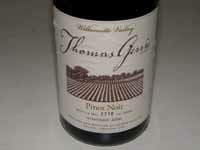 2010 Thomas Gerrie Wines Willamette Valley Pinot Noir 104 cases, $25. Native yeast fermentation, 100% whole cluster, aged a minimum of 17 months in French oak. Unfined and unfiltered. · Moderately light reddish color in the glass. Attractive scent of red cherry pie glaze, baking spice, toast and sandalwood. Lighter in weight than the 2009 version, but equally pleasurable, showing less whole cluster influence, and brighter acidity. Flavors of crisp red cherries and berries and spice backed by suave tannins. Delicate, even feminine in character, but offers a tasteful, seamless drinking experience. Score: 90
2009 Thomas Gerrie Wines Willamette Valley Pinot Noir 160 cases, $25. Average Brix at harvest 23.3º. Native yeast fermentation, 100% whole cluster. Aged 18-20 months on lees in French oak. Unfined and unfiltered. · Moderate reddish-purple color in the glass. Nicely appointed nose offering aromas of warm raspberries, blueberries, spice, oak and floral highlights. Tasty core of dark cherry, and dark red berry fruits with a subtle savory herbal undertone. Medium bodied with balanced tannins, taking on more interest and intensity in the glass over time. The wine possesses good tension and finishing intensity. Should improve over time in bottle. Score: 90
2011 Wind Gap Sonoma Coast Pinot Noir 12.4% alc., 300+ cases, $37. From Pax Mahle Wines in Forestville. · Medium garnet color in the glass. Delicate perfume of strawberry, cherry, red licorice and conifer. Lean and angular, featuring cherry and cranberry fruit with a green thread running through, finishing with a very tart, cherry skin finish. The fruit doesn’t seem ripe and the biting acidity is out of balance. Score: 84
2010 Windy Oaks Estate Terra Narro Schultze Family Vineyard Santa Cruz Mountains Pinot Noir 13.5% alc., $29. Unfined and unfiltered. · Moderate reddish-purple color in the glass. Complex array of aromas including spicy plum, red raspberry, clove, Asian 5-spice, pepper and a hint of oak. Straight forward and easy to drink, featuring dark red berries and spice backed by a generous tug of oak. Score: 87
13.9% alc., $55. Unfined and unfiltered. · Moderately light reddish-purple color in the glass. Aromas of ripe cherries and berries with appealing spice. Deep, dark red cherry and berry flavors with a note of cola and sarsaparilla. Easy going and silky in the mouth with a dry, noticeably generous finish. Score: 90
2012 Winter’s Hill Vineyard Dundee Hills Pinot Blanc 13.0% alc., 205 cases, $17. Processed in stainless steel without barrel aging or malolactic fermentation to highlight its fruit character. The wine was fermented three weeks until dry. · Light golden straw color and clear in the glass. An enjoyable example of this underrated varietal offering refreshing aromas of golden apple, pear, lemon and coconut and tasty flavors of green apple, pear and a hint of pineapple. Brisk, with lemon-driven acidity, gossamer tannins and a crisp finish. True to the grape. Score: 88
2012 Winter’s Hill Vineyard Dundee Hills Pinot Gris 14.5% alc., 800 cases, $17. Whole cluster pressed, fermented in stainless steel tanks at low temperature, no malolactic fermentation. · Pale golden yellow color and clear in the glass. I was drawn to this wine immediately, with its interesting aromas of fresh cut apple, tropical fruits, wax and a hint of lily. Pleasing on the slightly creamy palate, with flavors of baked pear and apple, leading to a palate cleansing finish. The wine shows a slight salinity to match well with oysters. Score: 90
2010 Winter’s Hill Vineyard Estate Bottled Dundee Hills Pinot Noir 13.0% alc., 195 cases, $34. Sourced exclusively from the Estate Vineyard. 100% de-stemmed, fermented in small 1.5-ton open top fermenters. Aged 24 months in 20% new French oak barrels. · Moderately light reddish-purple color in the glass. The aromas draw you into the glass, offering bright cherry, boysenberry, forest floor and smoky oak scents. Delicate and soft in the mouth, with the flavorful essence of fresh dark red cherries and berries, peppery spice and aromatic herbs. Finishes with a bright cut of acidity. Score: 88
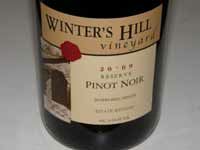 2009 Winter’s Hill Vineyard Reserve Estate Bottled Dundee Hills Pinot Noir 14.5% alc., 125 cases, $55. Made exclusively from grapes grown in the 35-acre Estate Vineyard located between Domaine Serene, Stoller Vineyards and Vista Hills Vineyard. Clones are Pommard, Wädenswil, 114 and 115. 100% destemmed, 24-hour cold soak, inoculated yeast fermentation, aged 31 months in 20% new French oak barrels. · Moderate reddish-purple color in the glass. A fruit-driven nose that has staying power in the glass over time. Enticing aromas of ripe cherries and raspberries with a hint of spice, briar and forest floor. Fullflavored with appealing roundness and pitch, featuring earth-kissed black cherries, black raspberries, and sassafras, set off by well-integrated tannins and acidity, finishing with a rush of spicy raspberry goodness. A riper fruit profile than the 2010 vintage bottling with more richness. Impeccable balance for aging. Hard to stop sipping this one. Score: 92
Pinot BriefsLouis Jadot Acquires Oregon Vineyard Wine Spectator (August 21, 2013) reported that Maison Louis Jadot bought the 32-acre Resonance Vineyard in the Yamhill-Carlton sub-appellation of the Willamette Valley for an undisclosed price. Beginning with the 2013 vintage, Jacques Lardiére, who retired as Jadot’s director of winemaking in 2012, will produce about 2,700 cases of an Oregon Pinot Noir at Trisaetum Winery. Resonance Vineyard has provided fruit to Lemelson, Sineann and Big Table Farm from its 19 acres of ownrooted Pinot Noir planted between 1981 and 2006. A Resonance Vineyard Pinot Noir has also been produced by the previous owners. Maison Louis Jadot is owned by the American Kopf family, which also owns the Kobrand import firm. This is the first venture outside of Burgundy for Maison Louis Jadot. Jackson Family Wines Buys Oregon Winery Jackson Family Wines recently acquired 300 acres of vineyard acreage in Oregon and has now bought Soléna Estate, a 15,000-case winery facility in the Yamhill-Carlton sub-appellation of the Willamette Valley owned by Laurent Montalieu and Danielle Andrus Montalieu. The Montalieus will retain their brand and move production to a different facility. Donum Estate Taking Great Strides Donum Estate consists of a 147-acre property spun off from the Buena Vista ranch more than a decade ago. Donum has recently contracted the 20-acre Angel Camp Vineyard in Anderson Valley and in 2012 acquired the Nugent Vineyard in the Russian River Valley. In July 2012, the winery assumed control of a 40-acre property adjacent the Carneros estate and will begin planting that parcel to vineyards. Much the new plantings will be the so-called Roederer clone which originated in the Hermann J. Weiner nursery in New York’s Finger Lake region, and is also named the Donum clone (a masalle selection). Replanting of 14 acres of the Donum Estate has also been undertaken, using Pommard, Calera, Wädenswil and Dijon 667 clones of Pinot Noir and Wente clone of Chardonnay. Two Wine apps Are Handy With the iOs app Drync, snap a photo of the label to see the price, ratings and tasting notes. The wine can ordered within seconds using a secure e-commerce platform and easy-to-use checkout function in the “Wine Cart.” Drync identifies 1.7 million wines using image recognition technology that works on bottle labels as well as labels pictured in magazines, and on signs and computer screens. Information can be shared with friends on Facebook, Twitter and email. I downloaded the Drync app and found a few drawbacks. The image recognition database does not contain all wines, so not every label is identifiable, and occasional the scanner identifies a wine incorrectly. The rating system (from 1 to 5 hearts) is based on users’ rather than critics ratings, and since the app is new, there aren’t many labels in the database. A second app, Delectable (first developed in 2011 with the newest version 3.0 now available) claims to be the No. 1 choice of wine drinkers, with users now approaching 1 million. Its database includes more than 2 million bottles. Delectable lets users snap a picture of a wine label with their iPhone, record their impressions, and but a wine through the app if it is available for purchase. The rating system is based on four types of faces with sad to happy expressions. Delectable claims its image recognition technology is nearly 100 percent accurate, and as I worked with it, I found this to be true. Personalized recommendations are offered on what to drink next based on what you have drunk in the past. Ordering is easy, and shipping is available to all 50 states. The main drawback is that identifying a label is not immediate and can take up to several hours, so it is not possible to order wine quickly. Because this app is well established, there are multiple ratings from several users for a number of wines and ratings of multiple vintages of the same wine are displayed. Both apps are free and downloadable through iTunes. World of Pinot Noir Donates $4,000 to Michael Bonaccorsi Foundation A significant donation was made to the Michael Bonaccorsi Foundations’s scholarship program at a recent Pinot Noir focused gathering at the Bacara Resort & Spa, the new location for the 2014 World of Pinot Noir. Michael Bonaccorsi was a respected sommelier and winemaker in Santa Barbara County but passed away suddenly in 2004. His legacy remains in the Michael Bonaccorsi Foundation, which awards scholarships to those striving to follow in his footsteps. The scholarships are made available through the Allan Hancock College Enology and Viticulture program. Visit www.hancockcollege.edu for information. The 14th World of Pinot Noir will be held February 29-March 1, 2014. More than 200 wineries specializing in Pinot Noir from throughout the world will be participating in two full days of seminars, tastings, dinners and special events. More than 2,000 guests attend the weekend events each year. For details on the World of Pinot Noir, visit www.wopn.com. The photograph below shows left to right: WOPN Board Members Leslie Renaud (Foley Wines), Karen Steinwachs (Seagrape Wine Co.) and Norm Yost (Flying Goat Cellars), Allan Hancock representatives Jeffr Cotter, Alfredo Koch and Dr. Paul Murphy, and Jenne Lee Bonaccorsi of Bonaccorsi Wine Co..
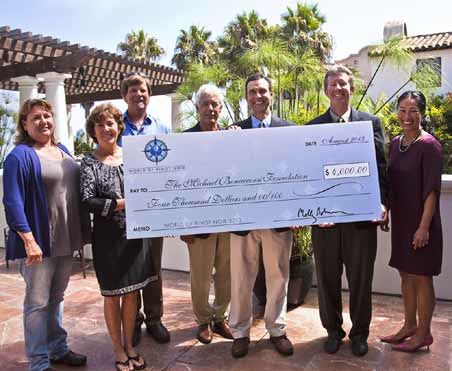 Pinot in the City Oregon’s Willamette Valley Wineries Association takes it on the road to Los Angeles on September 11, 2013. Over 69 Oregon wineries will be pouring Pinot Noir, Chardonnay, Pinot Gris, Riesling and more. The venue is The Ebell from 3:00 to 6:00. Tickets include all wine tasting, Pinot-friendly appetizers and a logo glass. Visit www.willamettewines.com/event/pinot-in-the-city/ for tickets ($75) and to see a list of participating wineries. The trade tasting will be held from 12:00 to 4:00.
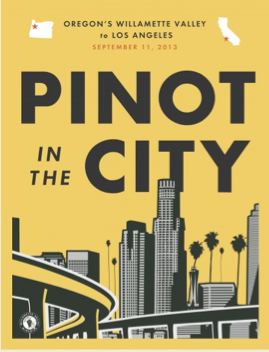 Sip For The Sea Benefit This food and wine event benefits the New York Aquarium by providing funds to repair damage caused by Hurricane Sandy. The date is September 12, 2013, from 6:00 to 9:00 at the Central Park Zoo in New York City. The Hess Collection, which works with the Monterey Bay Aquarium and the Seafood Watch program to promote sustainable seafood, has joined with the Wildlife Conservation Society and several other sponsors to offer wines from the entire Hess portfolio, paired with offerings from some of New York’s finest restaurants. Pull a cork for a penguin. For tickets, visit www.wcs.org/sipforthesea/. Alfresco Dining at The Madrones in Anderson Valley The Madrones’ Mediterranean compound in Anderson Valley now offers alfresco meals at the property’s newest addition, the Stone & Embers Restaurant. A wood-burning stove is at the heart of chef and owner Patrick Meany’s menu offerings. Meany was most recently the Chef de Cuisine at Heritage House in Mendocino and has worked at Bouchon Las Vegas and Gary Danko in San Francisco. Guests can stay overnight in one of The Madrones’ lovely Estate Guest Quarters. Stone & Embers is open daily (except Wednesday and Thursday) from 12:00 to 8:30. Stone & Embers is located at 9000 Hwy 128 in Philo (adjacent Goldeneye tasting room). Visit www.stoneandembers.com for more information. Clos Saron Fall Open House For something different, consider visiting the Clos Saron Fall Open House in the Sierra Foothills. This producer of Pinot Noir and various other red and white varietals of interest, is tiny but has taken on a cult following. The event on Saturday, October 19, 2013, will include a barrel tasting of the 2013 vintage, a preview of the 2011 Pinot Noirs, a picnic lunch in the vineyard, a tasting of several other wines spanning 13 harvests and a candle light gourmet dinner in the cellar. For further information, call the winery at 530-692-1080, email the winery at info@clossaron.com, or visit the winery’s website at www.clossaron.com. Experience Oregon Wine Harvest at SE Collective On September 26 to October 18, Portland’s urban winery, SE Wine Collective. Hands-on wine production experiences, punching down grapes, weekly happy hours, and more are offered at the 5,000-square-foot SE Wine Collective, located within minutes of downtown Portland at 2425 SE 35th Place. Vincent Wine Company, Helioterra Wines and Division Winemaking Company have been resident wineries for a year and newer resident wineries include Bow & Arrow Wines, Willful Wines and Fullerton Wines. Visit www.sewinecollective for more details. Head’s Up: KITÁ Wines I recently attended the Wine & Fire event in the Sta. Rita Hills, and although there were a number of wineries that stood out for me, I should give a head’s up to KITÁ Wines. I won’t be writing about the event for some time, so wanted to make you aware of this new producer. I thought their 2011 Pinot Noir was the best I tasted at the event. The brand is a collaboration between two accomplished vintners, general manager and head winemaker Tara Gomez and assistant winemaker Tymari LoRe. Several varietals are offered, but the 2011 Pinot Noir from Hilliard Bruce Vineyard in the Sta. Rita Hills was a stunning wine. I also tasted several single clone barrel samples from the 2012 vintage and these were equally impressive. Check out the full story at www.kitawines.com. Photo below shows Tara recently pouring wine for the California State Legislature.
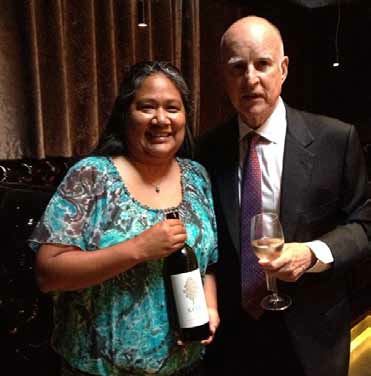 New Zealand Wines Marketed With More Antioxidant Balancing Act Wines, a new label from New Zealand, is offering a lineup of wines that contain 40 times more of the potentially health-promoting antioxidant, resveratrol (equivalent to consuming the resveratrol content in 40 glasses of normal wine). Recent research has found that the resveratrol is absorbed 250 times more effectively when consumed in wine as opposed to a supplement form, according to www.foodmag.com.au. The Balancing Act wines incorporate a technology developed by Australian antioxidant proponent, Dr. Phillip Norrie. The resveratrol load in the wine is said not to effect color, aroma or flavor. The wines have been introduced into the New Zealand market by Southern Wine NZ Ltd. Consensus Paper on Moderate Alcohol Consumption and Health A consensus paper written by 36 prominent Italian scientists (“Moderate alcohol use and health: a consensus document,” Nutrition, Metabolism & Cardiovascular Disease, 23:487-504, 2013) concluded, “Moderation in drinking and development of an associated lifestyle culture should be fostered.” However, the authors also emphasized that the choice to consume alcohol should be based on individual considerations, taking into account the influence of health and diet, the risk of abuse, the effect on behavior, and other factors that may vary with age and lifestyle. The paper was reviewed by The International Scientific Forum on Alcohol Research. Good data was presented to support the following: “In healthy adults and the elderly, spontaneous consumption of alcoholic beverages within 30 g ethanol/d for men and 15 g/d for women is acceptable. There is no evidence to suggest complete abstention from alcohol drinking by moderate users.” Second, “ Patients with increased risk for specific diseases, for example women with a family history of breast cancer, or subjects with a family history of early cardiovascular disease or current cardiovascular disease, should discuss their drinking habits with their physician.” There was no data to support the paper’s statement that “No abstainer should be advised to drink for health reasons,” and the Forum pointed out that the information presented in the paper tended to support the opposite conclusion. the take-away message is this: “Low levels of alcohol intake, that is, 1-2 drinks per day for women and 2-4 drinks per day for men, are inversely associated with total mortality in both men and women.”
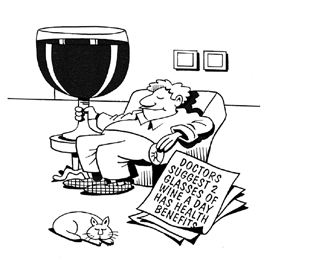 Sip! Mendocino Wine Tasting & Wine Shop Bernadette Byrne runs a popular tasting room and retail store for Mendocino wines. Many of the Pinot Noirs she carries are very small production including Masut, Judson Hale, Black Kite, Bink, Frati Horn, Witching Stick, Foursight, Baxter, and more. A special wine club is available called Pinot Please! Members receive quarterly selections of two different small production Mendocino County Pinot Noirs, typically two bottles of each, with a 20% discount. Members also receive exclusive invitations to PINOT-centric Sip! Trip excursions to Pinot Noir vineyard and winery experiences. Apparently Bernadette knows everyone in Mendocino County so is a good resource for finding wine produced in the region. She has been able to find me Pinot Noir that was not available anywhere else. Sip! Mendocino is located in Hopland at 13420 S. Hwy 101. Visit the website at www.SIPmendocino.com (if you don’t see a wine you want, call her at 707-744-8375). |